





























Ageing fleet refers to the fleet of ships and other naval assets that have been in service for a long time and are reaching the end of their operational lifespan. As these vessels and equipment age, they become increasingly expensive to maintain and repair, and they may become less reliable or less capable of carrying out their intended functions.
An AO refers to a specific geographic region or area where a naval force is deployed to carry out its mission. The AO can be defined by geographic boundaries, such as coastlines or territorial waters, or by operational considerations, such as a specific mission or objective. The AO can also be dynamic and change as the naval force's mission or objectives evolve. The AO can include both open waters and littoral areas. It can be influenced by a range of factors, including weather conditions, geopolitical considerations, and the presence of other naval forces or non-state actors.
The asset cast-off policy refers to the process of retiring or decommissioning older or outdated naval vessels and replacing them with newer, more modern ones. This policy is driven by several factors, including the need to maintain a capable navy, optimise resource allocation and cost-effectiveness, and comply to international treaties and agreements. This policy involves assessing the capabilities of the present fleet, evaluating the costs and benefits of the present assets and its replacement, and disposing of retired assets through sale, donation, or other means.
Concentric Areas refers to a layered approach to security that involves dividing a region or maritime space into concentric zones based on their security and defence characteristics. The innermost zone, closest to shore or key infrastructure, represents the highest level of security and may require the most intensive security measures, such as naval patrols or security checkpoints. The outer zones represent decreasing levels of security, with fewer security measures needed. This approach allows for a more focused and targeted use of resources and can help prevent security threats from reaching critical areas. However, it requires effective coordination and communication among maritime stakeholders to ensure effective security across all zones.
The CONOP is a plan that outlines how the ship will be used to accomplish its mission objectives. It describes how the ship will operate in different situations and roles. The CONOP details the ship's primary and secondary capabilities, the crew’s roles and responsibilities, procedures for different activities, logistics and support requirements, and relationships with other ships or units. The CONOP is an essential planning document developed collaboratively by naval commanders, planners, and experts. It is reviewed and updated as needed to reflect changes in the operational environment or mission requirements.

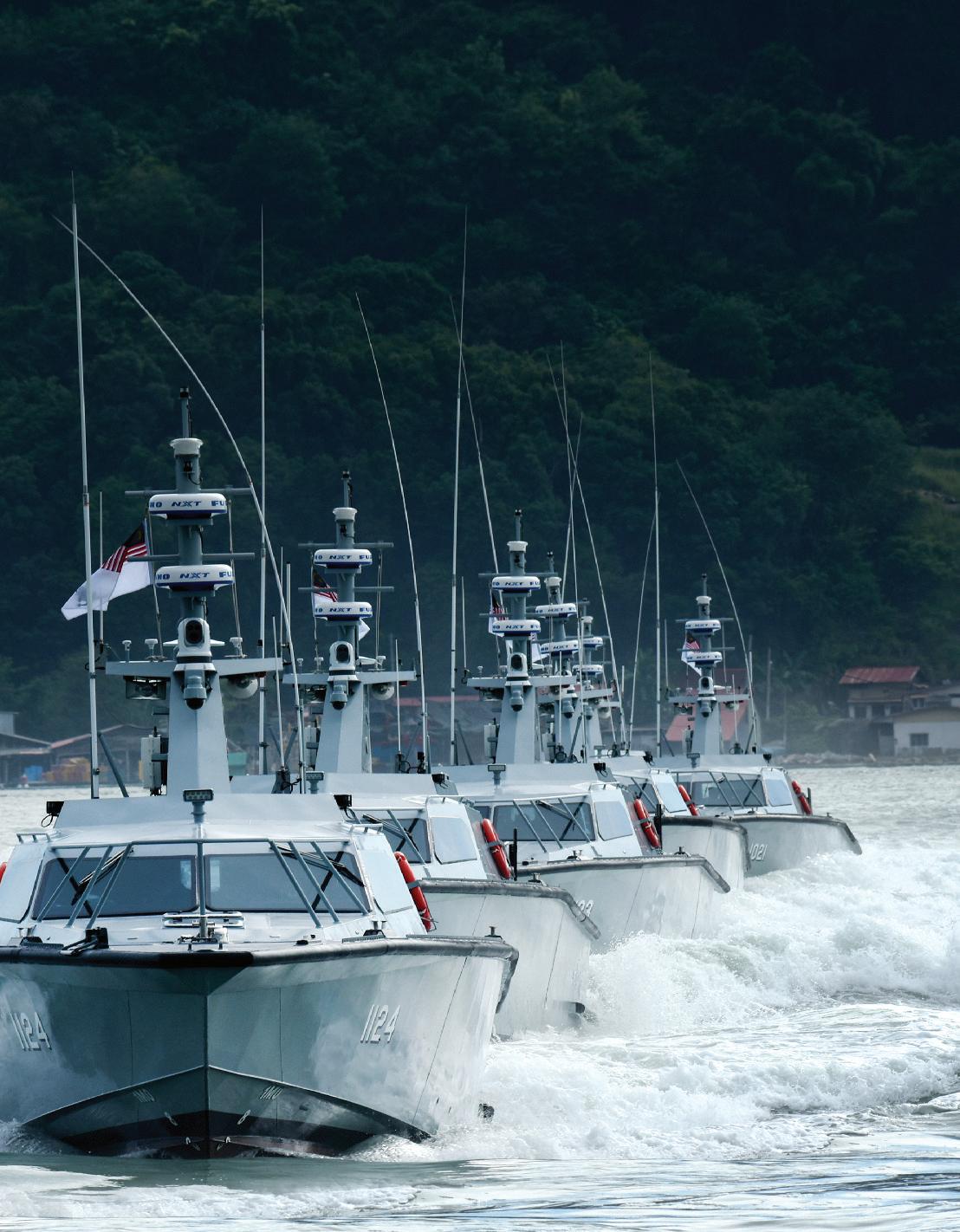
Critical National Interest refers to a country's most important and essential interests that are crucial for its survival, security, and prosperity. These interests include protecting the country from external threats, ensuring economic stability and growth, maintaining political stability, and preserving the environment. Critical National Interest is the foundation of a country's foreign and defence policies, and protecting these interests is vital for the country's overall well-being.
Defence diplomacy involves building relationships with other countries through military exchanges, joint exercises, and cooperation on security issues. The goal is to strengthen national security, enhance military capabilities, and promote regional stability. Defence diplomacy is an important aspect of a country’s foreign policy, as it helps to maintain good relations with other countries in the region and beyond.
The Malaysian DWP is a government document that outlines Malaysia's defence policy, strategies, and priorities for a specific period. It overviews Malaysia's security environment and identifies its defence requirements. The DWP also describes the roles and responsibilities of the military and other agencies, as well as the resources and funding needed to achieve Malaysia's defence goals. It also identifies areas where improvements are required and covers a range of defence issues, such as military modernisation, cybersecurity, and disaster response. The DWP is a planning tool for the government and the military and is regularly updated to reflect changes in the security environment or defence requirements.
The concept of a "Fleet in Being" is a strategic naval concept that emphasises the presence and potential threat of a naval force without necessarily engaging in combat. This doctrine suggests that the mere existence of a powerful and ready fleet can influence enemy decisions and strategies, even if that fleet remains in port or within its own territorial waters.
Force multipliers refer to tools or capabilities that help a navy become more effective and powerful than it would be with its existing resources. These force multipliers include advanced sensors, communication equipment, unmanned systems, air support, and intelligence-gathering capabilities. They help a navy extend its reach, increase situational awareness and conduct more complex operations with fewer resources. A navy can achieve its objectives more efficiently through force multipliers, with less risk to personnel and equipment.

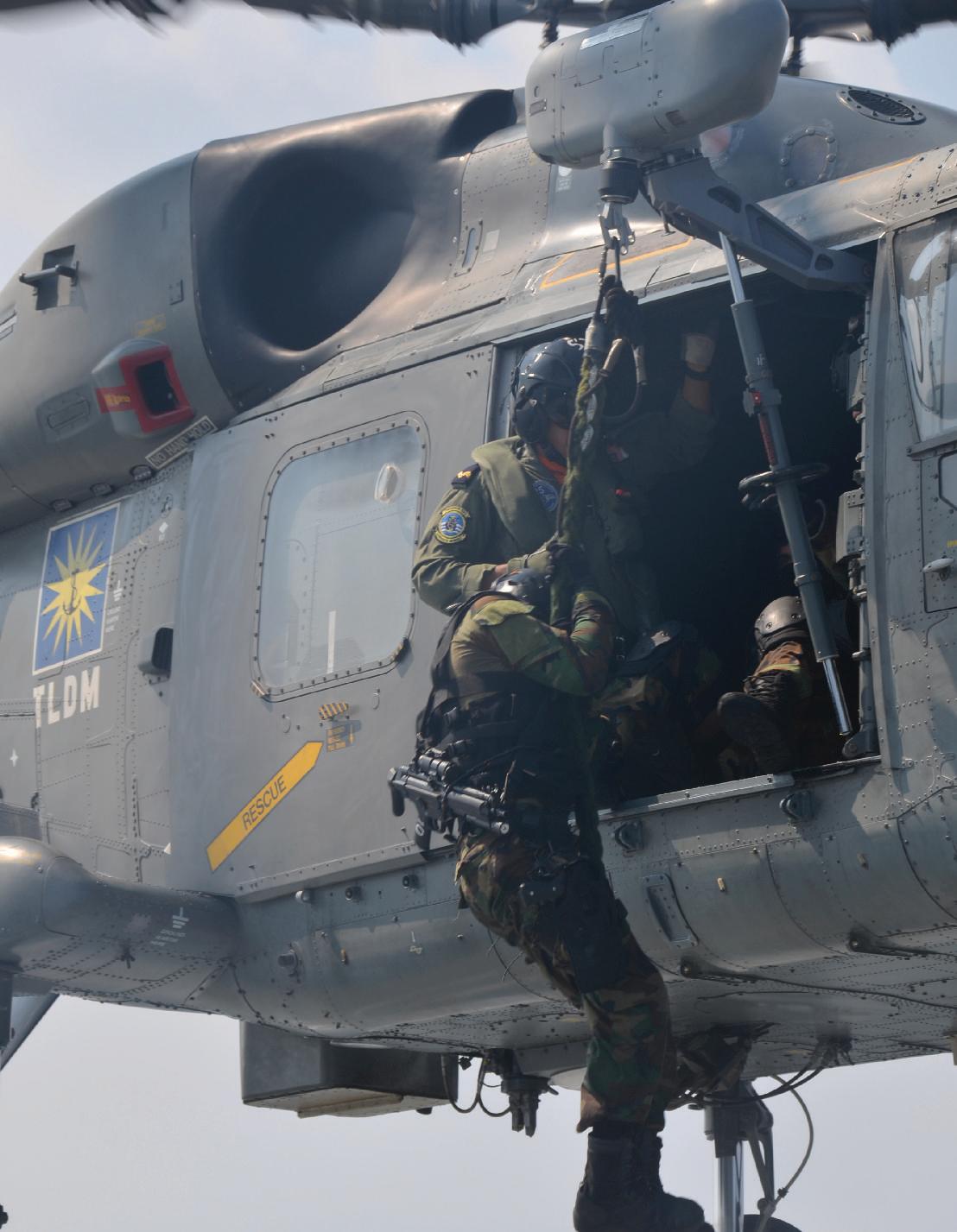
The RMN FS 40 is the interim strategy made by the RMN to address the widening capability gaps resulting from the ageing and deterioration of its current fleet. These measures will be executed within the Twelfth until Fifteenth Malaysia Plans (MP12 until MP15) until 2040, aiming to maintain and sustain the present fleet's capabilities until the RMN Baseline Force achieved.
Gap Fillers refer to temporary measures or assets used to address a shortfall in capability or resources. Gap Fillers are used when a naval force lacks the necessary resources, equipment, or personnel to carry out a mission. Gap Fillers are typically used as a stop-gap measure until the resources are required, equipment becomes available, or a permanent solution can be implemented. While they are not ideal, Gap Fillers can help a naval force maintain its readiness and effectiveness in the short term.
Great power politics is the interactions between major global powers, like the United States, China, Russia, and the European Union. It involves competition, rivalry, and cooperation, as each power tries to assert its interests and influence the international system. Military and economic power are important in great power politics, and powers may use diplomacy, sanctions, military force, or espionage to achieve their goals. It can affect the world significantly, and understanding great power politics is important for policymakers and global strategist.
The Guns Versus Butter Policy is an economic concept that describes the trade off between military spending (guns) and civilian spending (butter). In other words, it represents the decisions governments must make when allocating resources between military and civilian programs. The term "guns versus butter" is often used to describe the dilemma governments face during times of war or when there is a perceived threat to national security.
MRO is a set of activities that are carried out to keep ships and other maritime assets in good working condition, ensure their readiness for operations, and extend their lifespan. MRO in the maritime context can include routine maintenance tasks such as inspections, cleaning, and repairs and more complex activities such as overhaul, refitting, and modernization. MRO can be performed on a scheduled or unscheduled basis and involve various stakeholders, including shipyards, maintenance providers, and naval personnel. Effective MRO is critical to ensure maritime assets' reliability, safety, and effectiveness.

The Malaysian Armed Forces (MAF) Future Force or Angkatan Masa Hadapan (AMH) aimed to achieve the Concentric Deterence. The Future Force possesses six main characteristics which are Jointness, Interoperability, Technology-based, Logistics Efficiency, Able to Operate Simultaneously in Two Theatres and Mission-orientated. Possessing these, the force is rapid, deployable and multi-role, capable of operating in all four domains covering maritime, air, land and cyber electromagnetic, and able to engage multiple challenges along the concentric areas. The MAF force structure development currently in Design Phase (2024-2025) and moving towards Development Phase (2026-2030). The Application Phase (2030-2055) will be implemented after the previous phase completed.
The MMZ refers to the waters surrounding Malaysia, including the territorial sea, contiguous zone, exclusive economic zone (EEZ), and continental shelf. The MMZ extends up to continental shelf from Malaysia's baselines, covering an area of about 3.16 million square kilometers. The MMZ is significant to Malaysia because it is a vital source of marine resources, including fish, oil, and gas, and it serves as a strategic sea lane for trade and commerce. The management and protection of the MMZ are essential to ensure the sustainable use of its resources and to safeguard Malaysia's
Maritime mobility assets are categories of assets that provides critical logistical and maintenance support to the combatants and other vessels in the fleet. These assets are responsible for ensuring that naval vessels are properly supplied, fueled, and maintained, allowing them to remain at sea for extended periods and operate at peak efficiency. In addition to their logistical and maintenance roles, support assets also employed for a variety of other purposes, such as Amphibious Ops, Sealift Ops and Humanitarian Aids and Disaster Relief (HADR) Ops.
MSA is a term used to describe a range of equipment, platforms, and systems used to monitor and track maritime activities. These assets include ships, aircraft, unmanned systems, and shore-based facilities that gather and process information to detect and track maritime vessels and activities. MSAs are used for various purposes, including maritime security, search and rescue, fisheries management, environmental monitoring, and surveillance of illegal activities, such as piracy, smuggling, and trafficking. They may employ various technologies, such as radar, sonar, electro-optics, and satellite-based monitoring systems. In summary, MSAs are essential tools for ensuring maritime security and safety. They provide valuable information about maritime activities and enable
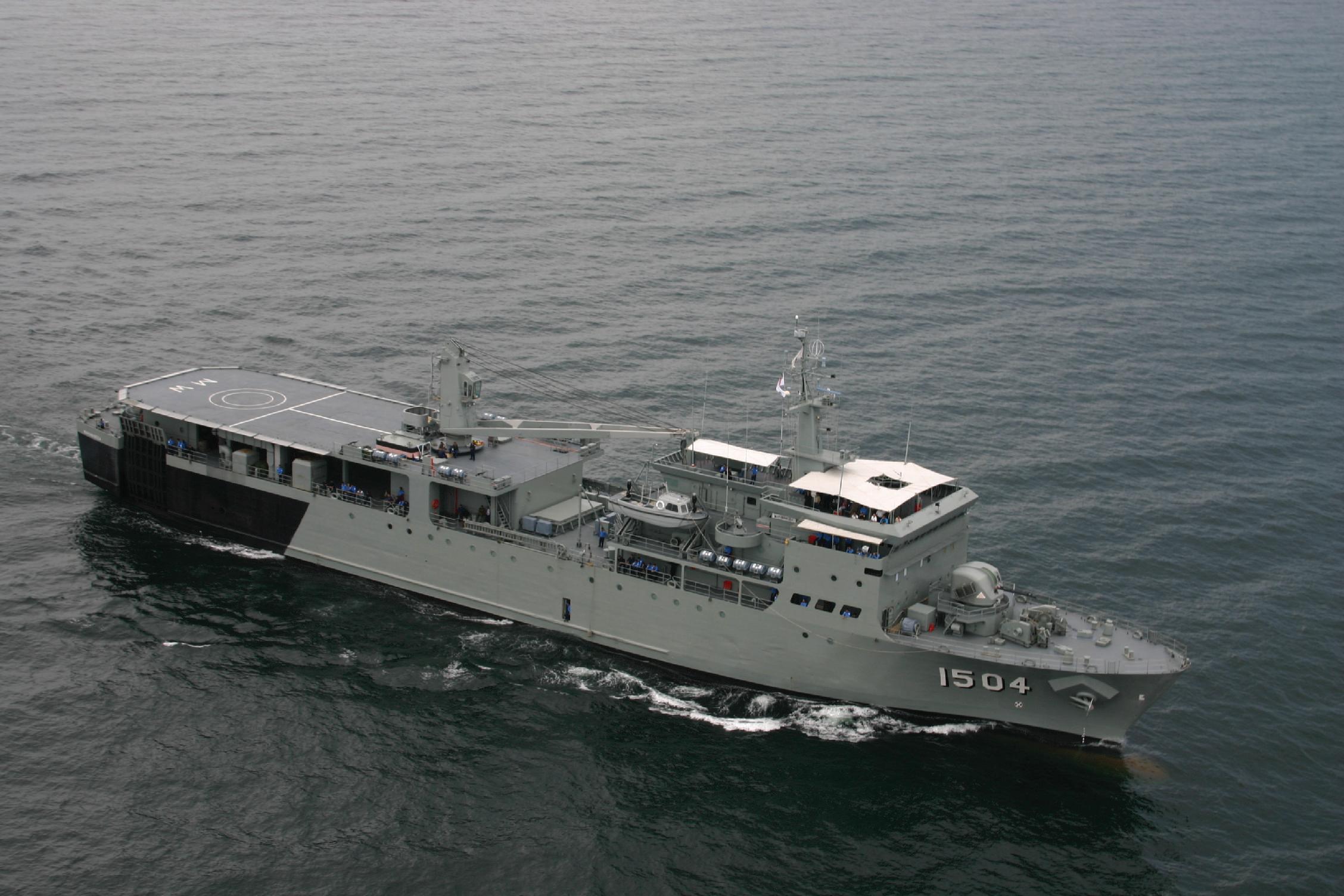
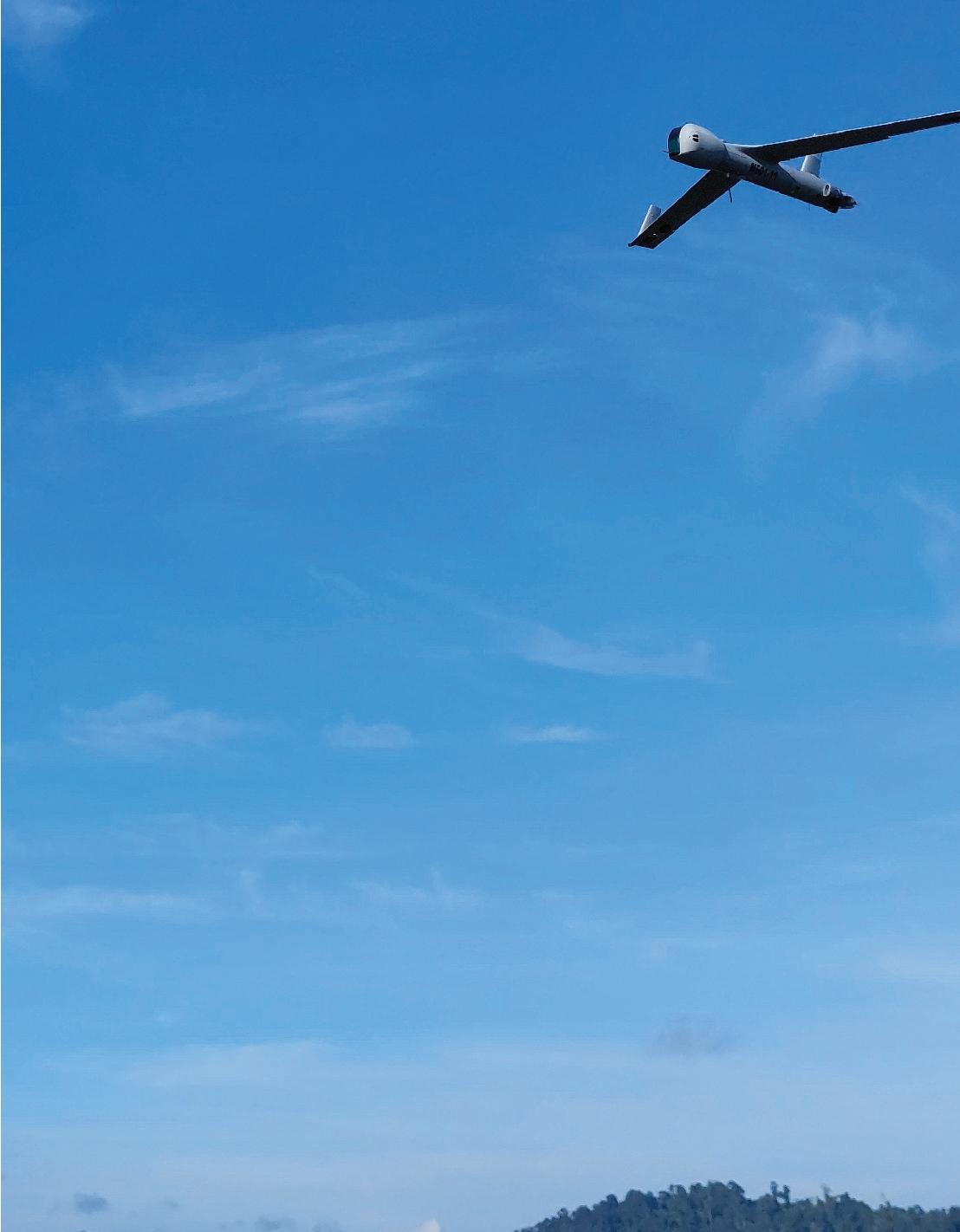


MOOTW are military activities that fall outside the scope of traditional warfare. MOOTW typically involve military support to diplomatic, economic, and humanitarian efforts and may include peacekeeping, disaster relief, and counter-terrorism activities. MOOTW aims to achieve the desired outcome through non-violent means while leveraging on military capabilities to support non-military efforts. MOOTW can involve a range of military assets, from ground troops to naval vessels and aircraft, and require close coordination with civilian organisations and host nations.
Priority assets in the navy are military resources that are considered crucial for mission to accomplish naval operations and objectives. They are determined based on factors such as war fighthing capabilities, strategic value, operational readiness, and overall contribution to the success of a mission. These assets are constantly monitored, assessed, and maintained to ensure they are always available when needed.
Re-Life Programme is the first initiative under the FS 40 strategy, which seeks to sustain and upgrade the existing fleet to achieve the desired sustainability and firepower while awaiting the procurement of new assets. This programme includes several initiatives such as the Service Life Extension Programme (SLEP) for Frigates and Next Generation Patrol Vessels (NGPVs), Mid-Life Upgrade (MLU) of the Scorpene Submarines, and Obsolescence Programme (OP) of Fast Attack Crafts and Laksamana Class Corvettes.
The 1/3 Management Concept is a management approach used by the RMN to ensure its fleet's optimal utilisation and maintenance. Using this concept, the RMN divides its fleet's management into three main fragments: one-third of the fleet is on active operational duty, one-third is ready to be deployed, and the remaining one-third is undergoing maintenance, repairs and training.
SLOCs refer to the routes ships and other maritime vessels use to transport goods, people, and military assets across the seas. These routes are essential for international trade, communication, and military operations, and their security is crucial to maintaining global stability and economic prosperity. SLOCs can include major shipping lanes, ports, and other key maritime infrastructure. They are often subject to a range of security threats, including piracy, terrorism, and other forms of maritime crime. Ensuring the security of SLOCs is critical for navies and other maritime security forces worldwide.


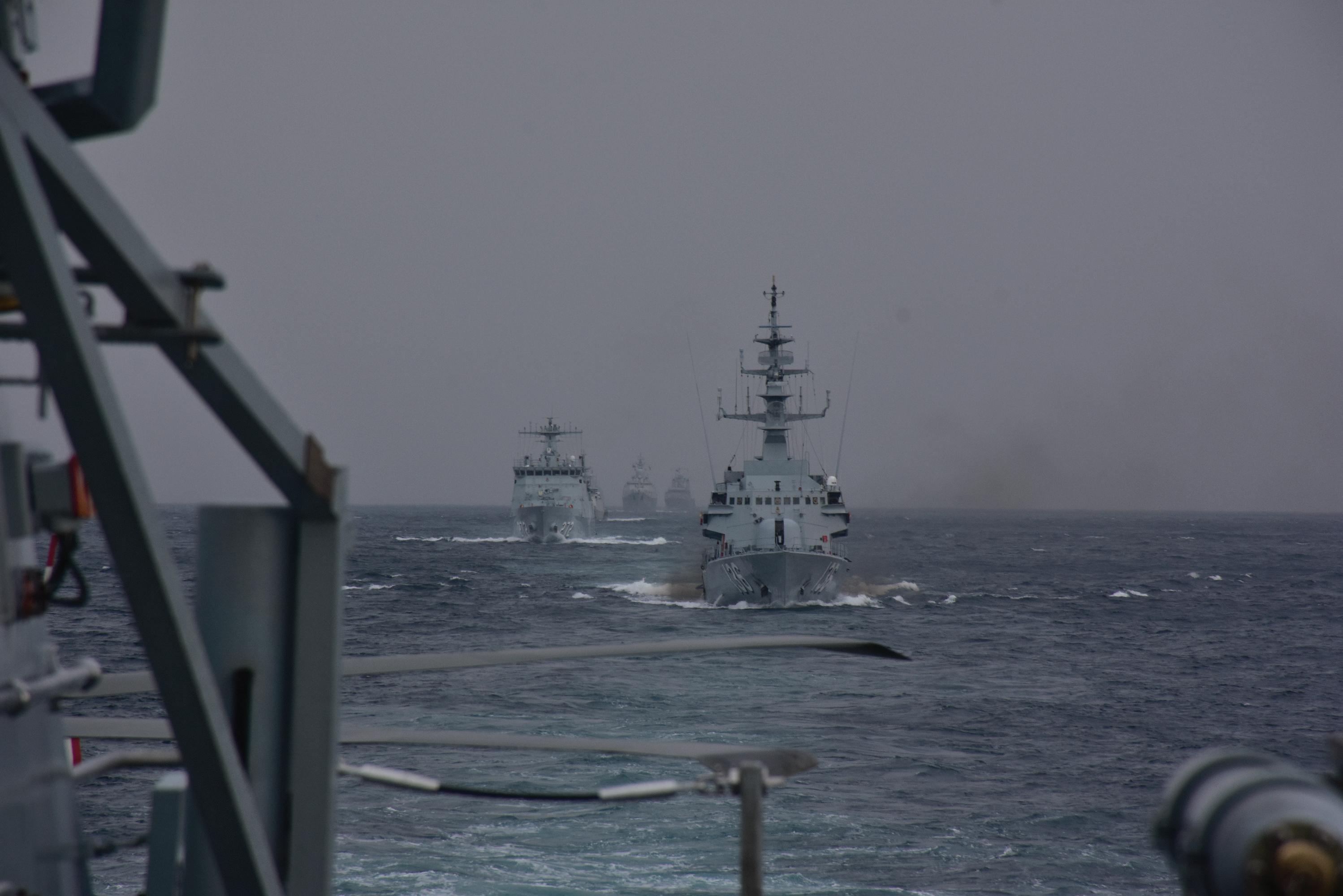
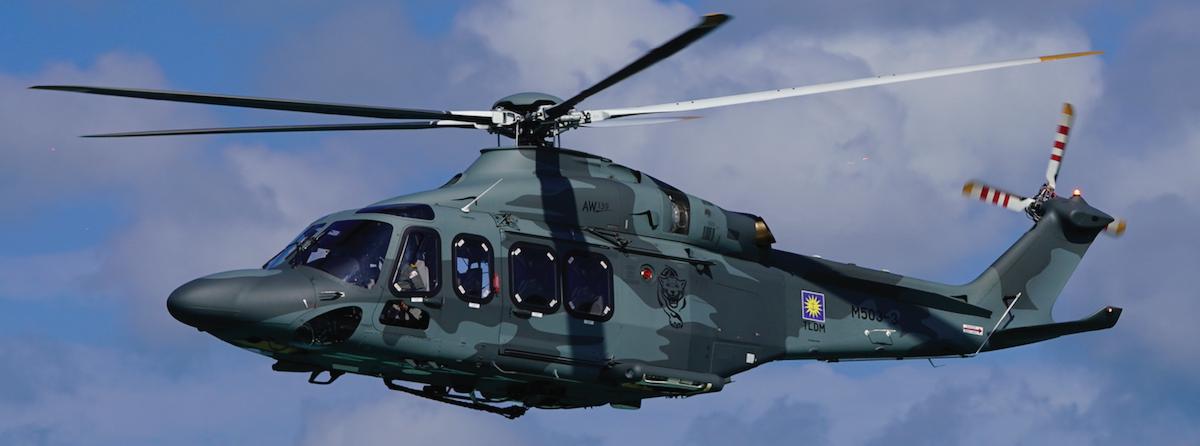



Support assets are essential to any modern naval force and categories of assets that provides tactical support to the combatants and other vessels in the fleet. Support assets are responsible for ensuring that the specific task are carried out to give tactical advantages to the combatant vessel. In addition to their support roles, support assets can also be employed for a variety of other purposes, such as Search and Rescue (SAR) and underwater search/identification. The support elements are the MCMV and Hydrographic Survey Vessel.
An UMA is a maritime zone that is not covered or protected by any country's exclusive economic zone (EEZ) or territorial waters. This means that no country has jurisdiction over this area, and it is considered to be part of the high seas. UMAs can be found in various locations around the world, and they are often subject to disputes between neighbouring countries over their ownership and control. The exploitation of resources in UMAs, such as fishing or oil and gas reserves, can also be a source of conflict.
The current geo-political situation is in a situation known as VUCA, stands for Volatility, Uncertainty, Complexity and Ambiguity. It is a situation where the security scenario is so dynamic and constantly changing in a short time and is difficult to predict. It demands security agencies to give an appropriate response to overcome the threats mentioned earlier.
WoGoS are approaches that bring together different stakeholders to achieve common goals. WoG involves multiple government agencies and departments working together, while WoS involves all stakeholders in society working together. Both approaches recognise the importance of collaboration and partnership across different sectors and stakeholders. WoG emphasises the integration and alignment of policies, programmes, and services across different parts of the government. WoS recognises that addressing complex challenges often requires a broad and diverse range of actors and resources.






Malaysia's maritime characteristics are accentuated by the fact that it is a nation surrounded by seas and fragmented by intervening waters, with the South China Sea (SCS) separating Peninsular Malaysia from Sabah and Sarawak. As a maritime nation, Malaysia possesses a strategic and geographic interest within its maritime territory and the Malaysian Maritime Zone (MMZ), constituting a vital source of the nation's economic wealth.
Its location is highly strategic as it connects two major water bodies which is Indian Ocean in the west and SCS in the east through important Sea Lines of Communications (SLOCs) such as the Straits of Malacca (SoM), Singapore Straits and Natuna Seas. By virtue of its MMZ, Malaysia has a maritime area which is two times larger than the land area. Our maritime sector is a key contributor to the country's socio-economic well-being, in which 90% of national trade is seaborne and the maritime industry contributes about 40% of the country’s annual Gross Domestic Product (GDP).
Due to this region's strategic connectivity and volatile nature, it is imperative to implement a robust strategy to safeguard Malaysia's maritime interests and ensure stability. In recent years, the security environment in Malaysia has been confronted with challenges from state and non-state actors marked by Volatility, Uncertainty, Complexity, and Ambiguity (VUCA). These challenges are mainly compounded by disorder, ideological and great power competition, and technological advancements, also known as Strategic Disruptors. In addition, there is a growing concern about illegal activities, such as trans-border crimes, sea robberies, Illegal, Unreported, and Unregulated (IUU) fishing, smuggling, and theft of natural resources by inappropriate entities within the MMZ. More seriously, the increasing trend of incursion by foreign vessels into the MMZ, which indirectly denies our rights to explore and exploit natural resources. This situation has challenged Malaysia's status and credibility as a sovereign country. These challenges are further exacerbated by Uncovered Maritime Area (UMA) within the MMZ, which doesn't have any surveillance footprint of its maritime enforcement agencies.
The country is also apprehensive about the fast-paced change in geopolitical climate in the region, as it sees a resurgence of old challenges and the rise of great power competition over natural resources in the SCS. This may affect the rich reserves of valuable resources such as crude oil, natural gas, minerals, marine life and other maritime interests within its MMZ. Additionally, the reorientation and reconstruction of regional middle powers' foreign and security policies and the rapid modernisation of military capabilities by some neighbouring countries over the past decade also posed strategic concerns, given that RMN's current combat capabilities are significantly lower than those nations.
The RMN is also expected to face a huge challenge to fulfil the exponential increase in operational and non-operational commitments with its current fleet, considering the degrading combat capability, delay in asset procurement, and ongoing fiscal challenges which hamper the planned for asset procurement.
Therefore, the government must address these new challenges and potential threats to national sovereignty in a prompt and effective manner. This includes realising the fact that the military is the key national instrument that plays a pivotal role in safeguarding the security and sovereignty of our nation. As threats to our national security continue to evolve, it is essential that the military is adequately prepared and equipped to defend against these threats, especially in preparing its assets and people for the possibility of conflict or war. The Lahad Datu Incursion in 2013, long-standing insurgencies by groups such as the Moro Islamic Liberation Front (MILF) and the communist New People's Army (NPA) in the Philippines, terrorist attacks by Islamic State of Iraq and Syria (ISIS) and other extremist organisations in Indonesia, and a long-standing insurgency by ethnic Malay Muslim separatists in the southern provinces of Thailand are incidents that underscore the evolving and enduring nature of security challenges in the region. The security threats are multi-dimensional emanating from both state and non-state actors, precipitating the need to be prepared to deter, deny and defeat any potentialities. By investing in our military and providing the necessary resources and training, we can ensure that our armed forces are ready to protect our nation and its citizens in the face of any challenge.
To effectively fulfil its fundamental role of protecting and safeguarding national sovereignty and territorial integrity, the RMN recognises the need to re-align the RMN 15to5 Transformation Programme. This initiative is intended to address the challenges faced by the RMN and ensure that the fleet can effectively fulfil its tasks and missions. This includes a thorough study of various matters, including the present force posture, appreciation of the emerging challenges that may impact future force planning, and analysis of future force requirements to maintain the credibility of the RMN in the future.
This supplementary document will supplement and re-align the current RMN 15to5 Transformation Programme initiative. The programme will span until the year 2055 and will register the strategies used in determining the future force requirements through the Standard Surveillance Block (SSB
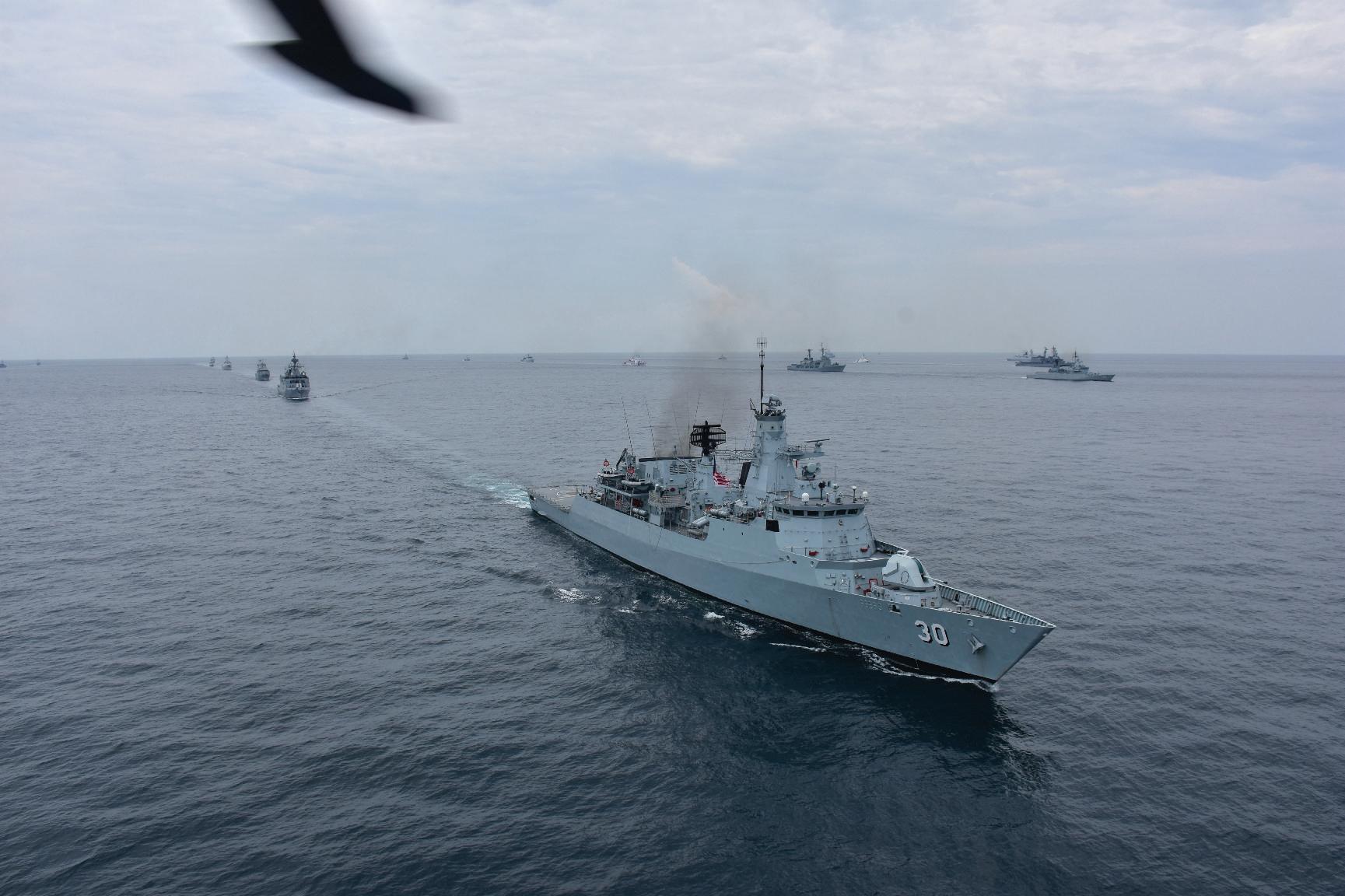
Force Structure 2040 (FS 40), which will serve as interim measures to bridge the gap while awaiting the completion of the RMN Base Line Force. The Base Line Force will underline the categorisation, capabilities and disposition strategy of future RMN assets. All these measures will be briefly explained later in this document.

The changing dynamics in the regional geopolitical climate demand that every nation adopts a more critical and comprehensive mindset, especially in its military capability development. The countries should consider traditional military capabilities such as weapons and personnel and explore emerging technologies and concepts such as cyber warfare, space capabilities, and intelligence gathering. Furthermore, countries need to enhance their military readiness and adaptability to handle unconventional threats posed by non-state actors, such as terrorism, insurgencies, and cyber-attacks. In essence, this statement calls for nations to be proactive and forward-thinking in their military capability development, so they can effectively respond to the evolving security challenges of the region.
As one of the many instruments of national power, there is a need for the Malaysian Armed Forces (MAF), particularly the RMN, to be evolved into a modern and capable force to carry out concentric deterrence to protect and safeguard Malaysia's national sovereignty, territorial integrity and Critical National Interests that lies along the MMZ. On top of that, it is crucial for the RMN to prepare the fleet and enhance its capabilities in order to support MAF Future Force (Angkatan Masa Hadapan) which to be fully implemented starting from 2030 onwards.
This section of the supplementary document explains RMN's re-alignment strategy, which aims to develop a more agile, lethal, and resilient naval force capable of effectively addressing current and future maritime security challenges and achieving national objectives. The three-pillar defence strategy outlined in the


Defence White Paper (DWP) serves as a guiding principle for this effort. Additionally, this section aims to analyse the potential challenges that may affect the RMN's future force planning, as outlined in the current RMN 15to5 Transformation Programme. This analysis will involve conducting a reality check to determine whether the RMN's force planning is robust enough to overcome these challenges in the future.
Defence White Paper (DWP) serves as a guiding principle for this this section aims to analyse the potential challenges that may affect force planning, as outlined in the current RMN 15to5 Transformation This analysis will involve conducting a reality check to determine force planning is robust enough to overcome these challenges in

CONCENTRIC DETERRENCE

Who
Malaysian Armed Forced
Purpose
“Deterrence”
Dissuading all forms of external intrusion or conflict
Process
“Concentric”
Jointness in defending national interest along the three concentric layers
COMPREHENSIVE DEFFENCE
Who
Whole-of-Government & Whole-of-Society
Purpose
“Defence Resilience”
Building and strengthening
Process
“Comprehensive”
Continuosly building internal unity, defence capabilities, security preparedness, inter-agency coordination, and overal resilience
CREDIBLE PARTNERHIP
Who
External Partners (Bilateral & Multilateral)
Purpose
“Partnerships”
Strengthening and widening external defence partnerships
Process
“Credible”
Maintaining Malaysia as a credible partner, while contributing towards capacity-building and regional stablity
Malaysia’s defence strategy is based on three essential pillars that are closely interconnected and mutually reinforcing. These pillars include Concentric Deterrence, Comprehensive Defence, and Credible Partnerships. Concentric Deterrence the primary pillar, involves the primary role of the MAF in protecting the country’s national interests, specifically by deterring all forms of external intrusion and conflicts and defending its sovereignty and territorial integrity, which is closely related to its primary role, which is to defend Malaysia’s maritime interests and territorial waters, protect the country’s sovereignty, and support the MAF in the overall defence of the nation. This includes ensuring that the Strategic Waterways along the country’s SLOCs are always open and can be transited at all times.
As a significant component of Malaysia’s maritime defence, RMN plays a crucial role in safeguarding the nation’s maritime interests, in line with the National Security Policy (NSP). In the event of a conflict or war, the RMN is responsible for protecting Malaysia’s maritime territory from internal and external threats, which is vital to the country’s security and stability. The RMN is committed to maintaining regional integrity and is fully prepared to defend the nation’s maritime interests, ensuring that Malaysia’s sovereignty and territorial integrity remain protected.
The RMN forms a crucial part of Malaysia’s defence strategy, serving as a key pillar of the country’s maritime defence. Presently, the RMN operates a variety of assets and capabilities, including surface vessels, submarines, helicopters, Unmanned Aerial System (UAS) and a range of other advanced technologies, to ensure the security and protection of Malaysia’s territorial waters. Furthermore, the RMN works closely with other branches of the MAF and government agencies to promote national security and safeguard Malaysia’s interests. The RMN is dedicated to maintaining a strong and effective maritime presence, which is essential to the country’s prosperity and well-being.
During peacetime, the RMN plays a critical role in Comprehensive Defence by adopting a Whole-of-Government and Whole-of-Society (WoGoS) approach to support various agencies in preventing activities that could threaten Malaysia’s security. The RMN works closely with other government agencies and the broader society to address potential security risks and enhance national resilience
Moreover, the RMN controls and monitors incursions within MMZ and safeguards important maritime resources. This includes patrolling Malaysia’s territorial waters, detecting and interdicting illegal activities such as piracy, sea robbery, illegal fishing, and smuggling, and ensuring that international laws and regulations are upheld.
To achieve its peacetime objectives, the RMN employs a range of capabilities, including naval patrol vessels, maritime surveillance systems, and intelligence-gathering assets. The RMN also collaborates with other agencies, such as the Malaysian Maritime Enforcement Agency (MMEA) and the Royal Malaysian Air Force (RMAF), to enhance its ability to maintain maritime security and respond to potential threats.
In addition to its maritime enforcement activities, the RMN is involved in various operational and regional engagements as part of its Defence Diplomacy and Credible Partnership commitments. Participation in bilateral and multilateral exercises allows the RMN to improve its interoperability with other navies and learn best practices in naval operations. It also provides a platform for the RMN to test its equipment and personnel, and exercise the best practices in naval operations. Operational visits are also key to the RMN’s regional engagement efforts. These visits help to build trust and understanding between the navies and promote goodwill between the nations. In addition to these activities, the RMN also plays an important role in providing Humanitarian and Disaster Relief (HADR) and Search and Rescue (SAR) operations in the region. Lastly, the RMN is also involved in civilian shipping protection activities, providing security to commercial vessels in high-risk areas. This helps prevent piracy and other illegal activities, thereby ensuring the safe passage of goods and commodities through the region.
The implementation of these measures also serves as confidence-building steps that will not only strengthen the commitment of the RMN to regional security but also promote diplomatic relations with neighbouring countries. By adopting a pragmatic approach towards regional security challenges and collaborating with other countries to enhance maritime domain awareness and respond to potential threats, the RMN can demonstrate its readiness and willingness to contribute to regional stability. This, in turn, could foster a sense of mutual trust and cooperation among regional states, facilitating diplomatic efforts toward resolving disputes and promoting shared security interests and stability in the region.
RMN’S OPERATIONAL IMPERATIVES
RMN’S OPERATIONAL IMPERATIVES
In order to guarantee optimal operational effectiveness, the RMN is required to develop adequate capabilities in its fleet to preserve and safeguard the Critical National Interests and protect national resources that lies along the four areas of interest and Strategic Waterways along the MMZ, namely the Straits of Malacca, Eastern Peninsula of Malaysia, SCS and Sulu Seas. The development of sufficient capabilities will enable the RMN to obtain the required abilities to become a respectable and effective Fleet in Being, which will ultimately be important for RMN to carry out sea denial, naval deterrence and sustainment activities effectively.
order to guarantee optimal operational effectiveness, the RMN is required to develop adequate capabilities in its fleet to preserve and safeguard the Critical National Interests and protect national resources that lies along the four areas of interest and Strategic Waterways along the MMZ, namely the Straits of Malacca, Eastern Peninsula of Malaysia, SCS and Sulu Seas. The development of sufficient capabilities will enable the RMN to obtain the required abilities to become a respectable and effective Fleet in Being, which will ultimately be important for RMN to out sea denial, naval deterrence and sustainment activities effectively.

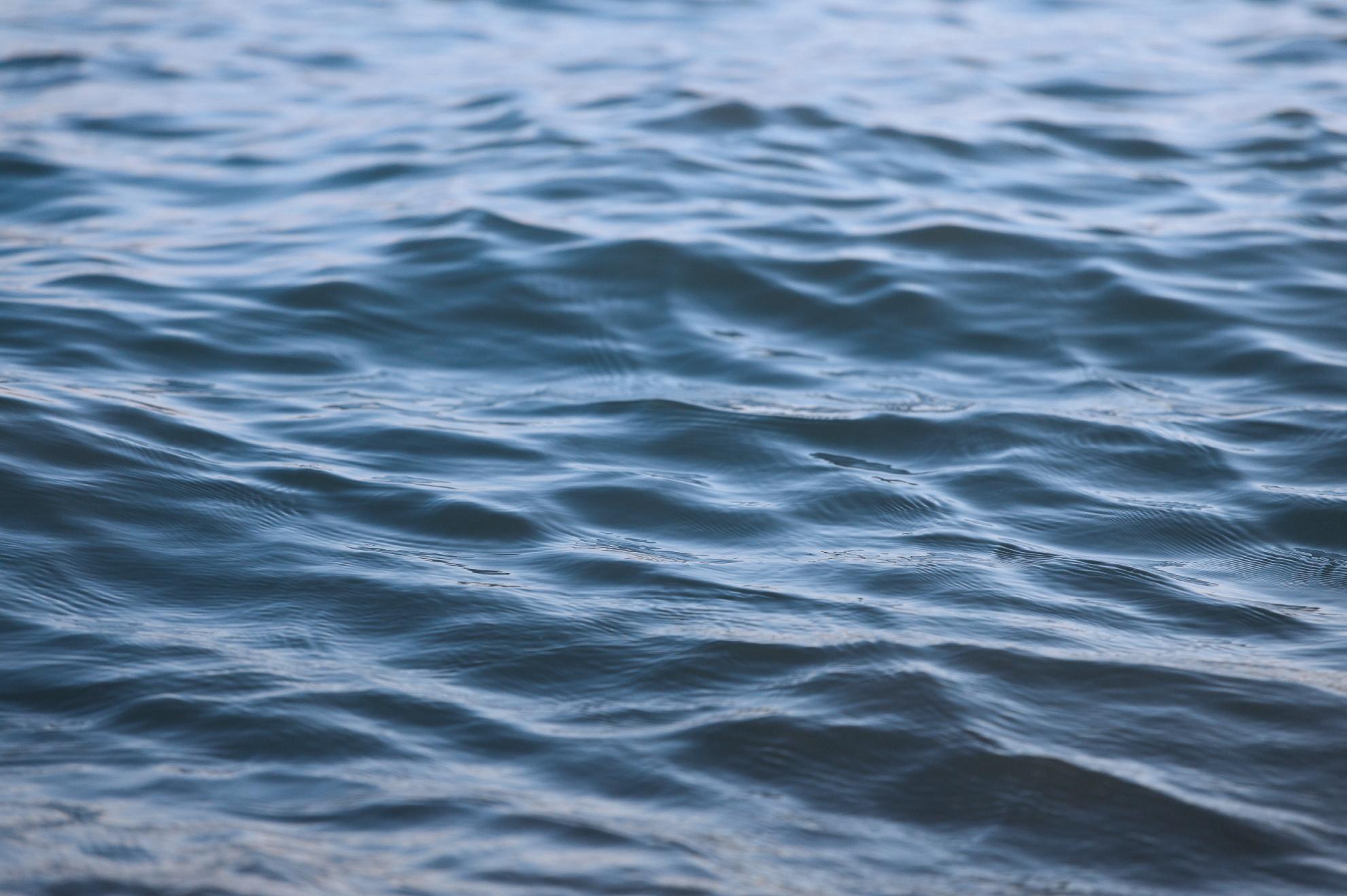


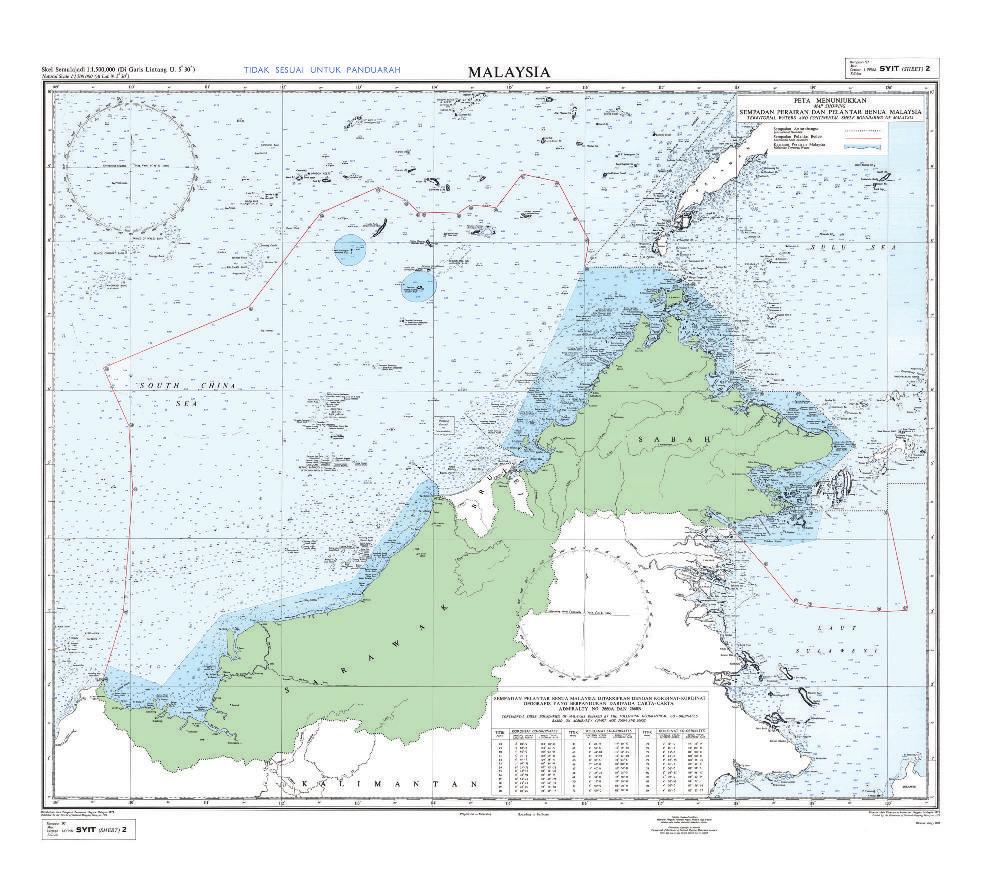
Malaysian Maritime Zone (MMZ)
569,845 km²
Sarawak & Sabah Maritime Area
387,959 km² - 67%





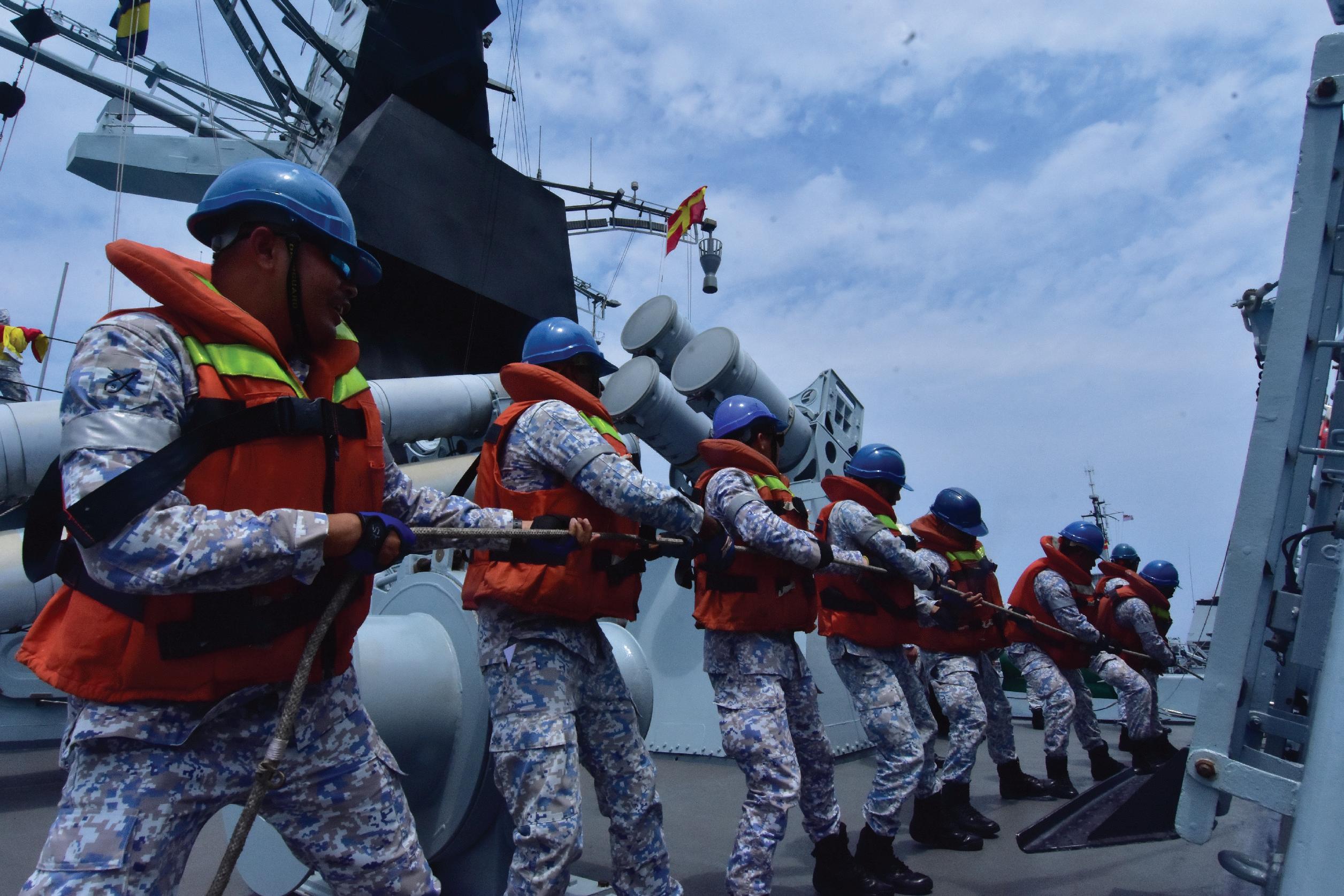



and Eastern Sabah waters, also referred to as the Sulu Seas. The division of the RMN's Fleet into a two-theatre command structure was a strategic move aimed at addressing the evolving security challenges in the MMZ and enhancing the disposition of assets through procuring new ones in the RMN 15to5 Transformation Programme. This restructuring has allowed the RMN to optimise its resources, enabling a more efficient and effective response to evolving security threats in both theatres.
With this configuration, the RMN slated to be able to protect the national sovereignty, territorial integrity, and maritime interests of Malaysia while at the same time enforcing maritime law and conducting Military Operations Other Than War (MOOTW) as well as supporting WoGoS tasks during peacetime. Moreover, this strategy provides a sound framework to safeguard the country's maritime resources, including its rich oil, natural gas deposits and other marine resources found within its MMZ.




In Malaysia, the security environment is influenced by a range of challenges that stem from state and non-state actors characterised by VUCA that are often fed by disorder, ideological and great power competition as well as technological advancements, also known as the Strategic Disruptors. The country's strategic location, situated between the strategic SLOCs such as the Indian Ocean, SoM and SCS, makes it a vital transportation hub for international trade. As such, Malaysia is exposed to various security challenges, including maritime piracy, terrorism, territorial disputes, transnational crime, and cyber threats.
Regional dynamics and geopolitical competition also shape Malaysia's security environment. The SCS territorial disputes, for instance, have led to increased tensions in the region, with several claimant states involved in a complex game of power politics. Additionally, Malaysia has to navigate the strategic competition between the Great Power Politics that is taking centre stage in the SCS, significantly impacting the region's stability and security.
Non-state actors, including terrorist organisations and transnational criminal groups, also pose significant challenges to Malaysia's security. The country has been a target of terrorist and militant attacks in the past, and there are concerns that extremist groups continue to threaten its security. The presence of grey warfare tactics, including cyber threats, also represents a growing challenge for countries in the region, including Malaysia, which has faced various attacks on its critical infrastructure and government networks in recent years. Taking these into consideration, the country must find the best solution to effectively navigate geopolitical competition, territorial disputes, transnational crime, terrorism, and cyber threats while safeguarding its national security interests.
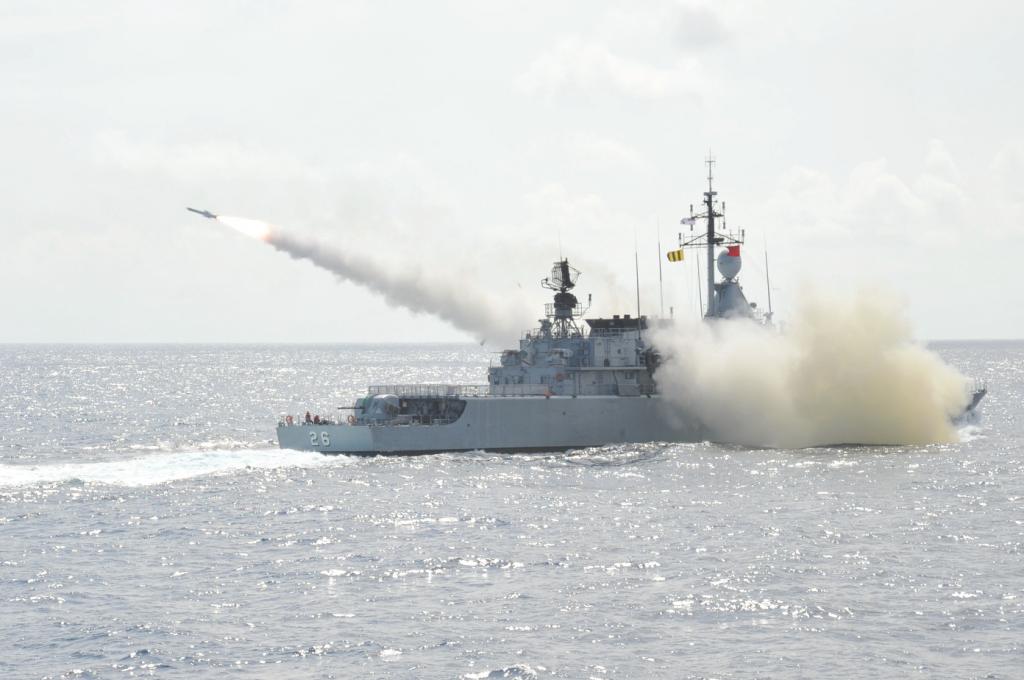
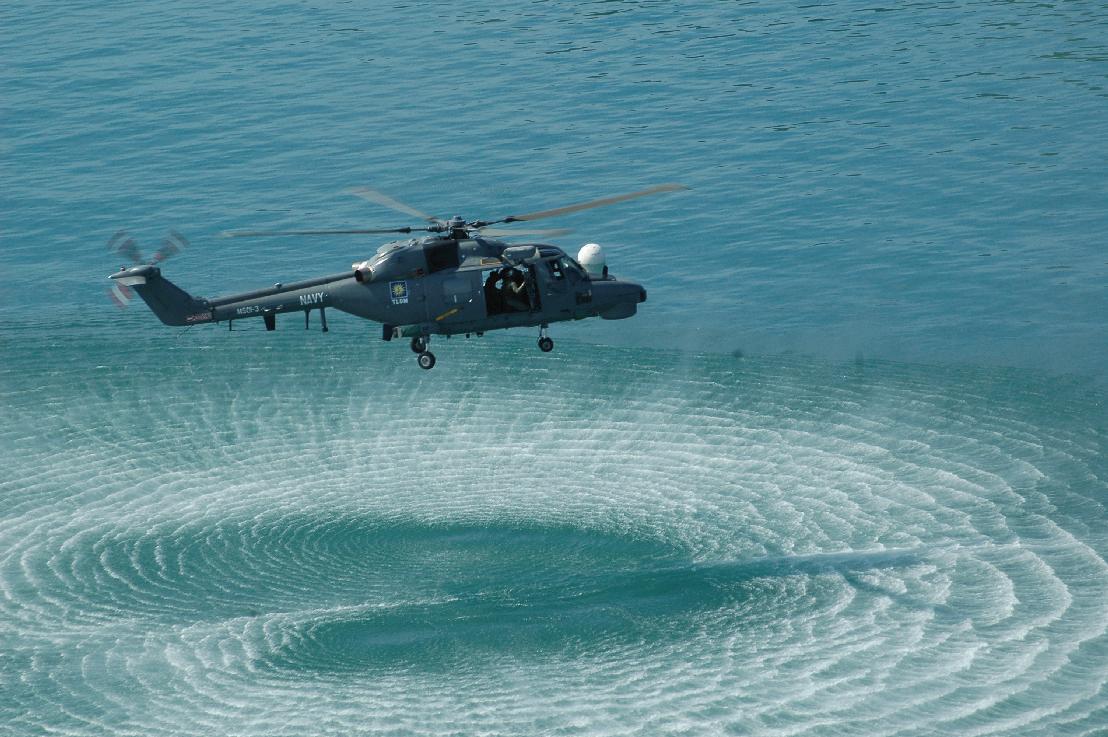
The RMN has faced a significant challenge in maintaining and sustaining its ageing fleet while fulfilling increasing commitments in recent years. The RMN has been unable to replace its ageing fleet as planned earlier due to procurement and asset replacement delays initially planned in the RMN 15to5 Transformation Programme. Currently, 60% of the RMN's ships are over 30 years old and have been troubled with numerous operational constraints due to obsolescence. This has resulted in frequent asset downtime and reduced operational performance of a huge number of ships in the RMN Fleet. However, despite these challenges, the RMN must maintain its high level of readiness by using its ageing assets to the best of its ability.
The operational tempo has increased exponentially over the past years, putting a strain on the RMN's Fleet and resulting in most of its ships being utilised beyond their normal operational turnover routines. This has led to reduced time available for maintenance and upkeep, causing problems such as obsolescence, degrading capabilities, and increased maintenance downtime. These numbers are also predicted to increase over the coming years, which will impose a huge challenge for the RMN to fulfil all tasks with its current fleet, considering the present number, degrading condition, and asset procurement delay plaguing the RMN over the recent years.
THE WAY FORWARD - RE-ALIGNMENT OF THE RMN 15TO5 PROGRAMME
The RMN places great importance on ensuring its assets' operational readiness and sustainability are sufficient to fulfil the duties and meet the objectives. However, due to increasing commitments and demands, the RMN has faced significant challenges in maintaining and sustaining its ageing fleet. The RMN recognises the need for a more robust and effective operational and maintenance model to address these challenges. This includes adopting a practical approach to maintenance, such as predictive and preventive maintenance, to reduce downtime and increase operational availability. It also involves investing in modernisation and replacing outdated assets to ensure that the RMN maintains its operational capability in the long term.
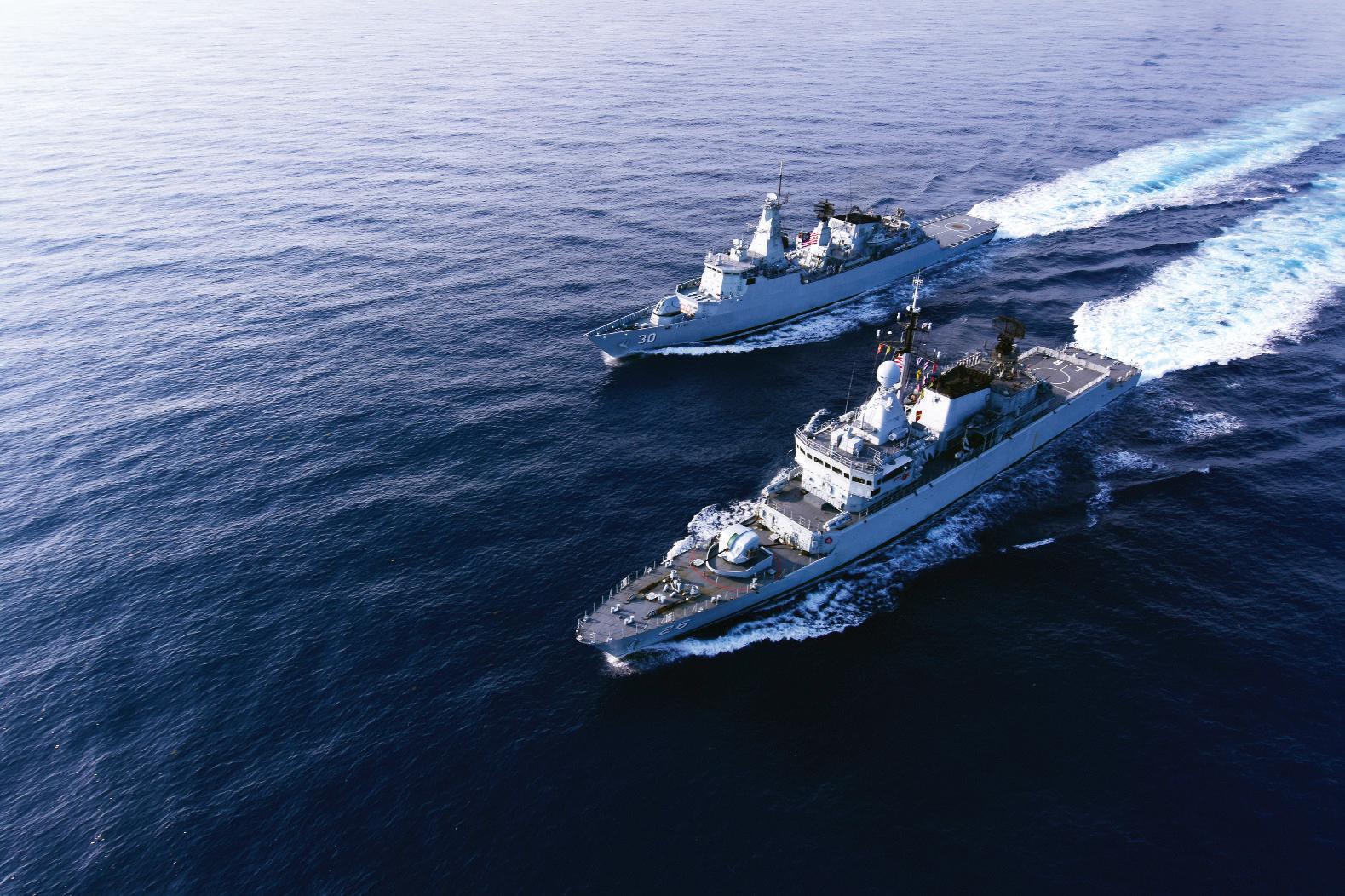
The following section of this document thoroughly evaluates the RMN's force planning and its capability to address the challenges highlighted in Chapter 2.
The RMN conducted a comprehensive study that focused on two significant areas. The first is understanding the basic asset requirements for effective surveillance and enforcement.
The second involves analysing the relevant force composition required by the RMN to cater to future challenges in naval operations. The findings of this study will provide valuable insights into developing effective force planning strategies to maintain the RMN's operational readiness and capability in the long term.

Locations beyond the extended area where Malaysia’s national interests are affected
Malaysian Maritime Zone (MMZ), strategic waterways, airspace and critical lines of communications
The land masses of Peninsular Malaysia, Sabah and Sarawak: the territorial waters: as well as the air space above them
Concentric Areas
The RMN has identified the need to deploy its assets in a wide range of maritime enforcement and protection operations due to the evolving challenges in the regional maritime security terrain and the increasing complexity of operational duties. These operations are necessary to ensure the safety and security of Malaysia's waters within and beyond Malacca, Singapore, and Indonesia. To effectively execute these tasks, the DWP has underlined Malaysia's interests into three layers: the Core Area, Extended Area and Forward Area. Protecting and defending Malaysia's areas of interest against external threats must be an utmost priority.
These areas of interest consist of the Core Area, which includes the administrative capital, socioeconomic centres, and densely populated areas. Conversely, the Extended Area is abundant in living and non-living resources, particularly hydrocarbons, contributing significantly to Malaysia's revenue. Finally, the Forward Area encompasses beyond the Extended Area, with national interests centred on regional stability and global peace efforts. Malaysia must secure these areas, as they are vital to its economic and political stability and overall security.
• Containment Strategy
• Protection of strategic waterways and maritime interest
• Denial and Assertion Strategy
• Safety and security of MMZ
• Protection of blue economy and natural resources
• Fortification Strategy
• Protection of harbour and strategic installations
these requirements, the RMN needs to develop a force structure conducting a Fortification Strategy, Denial and Assertion Strategy, and Strategy to protect the Concentric Areas, as underlined in the DWP.
Based on these requirements, the RMN needs to develop a force structure capable of conducting a Fortification Strategy, Denial and Assertion Strategy, and Containment Strategy to protect the Concentric Areas, as underlined in the DWP.
RMN has identified strategic waterways that including the SoM, Malaysia waters, the Sabah Waters. These be prone to illegal armed robbery, and threats, which pose a safety and security community.
Besides that, the RMN has identified four crucial strategic waterways that require coverage, including the SoM, Eastern Peninsula Malaysia waters, the SCS, and Eastern Sabah Waters. These areas are known to be prone to illegal incursions, piracy, armed robbery, and other maritime threats, which pose a significant risk to the safety and security of the maritime community.
ensure the safety and Malaysia's maritime domain, extend its surveillance presence beyond its areas to include the refers to areas not or patrolled by the maritime enforcement therefore represents a
Also, to ensure the safety and security of Malaysia's maritime domain, the RMN must extend its surveillance and maritime presence beyond its current coverage areas to include the UMA. The UMA refers to areas not currently monitored or patrolled by the RMN or other maritime enforcement agencies and therefore represents a
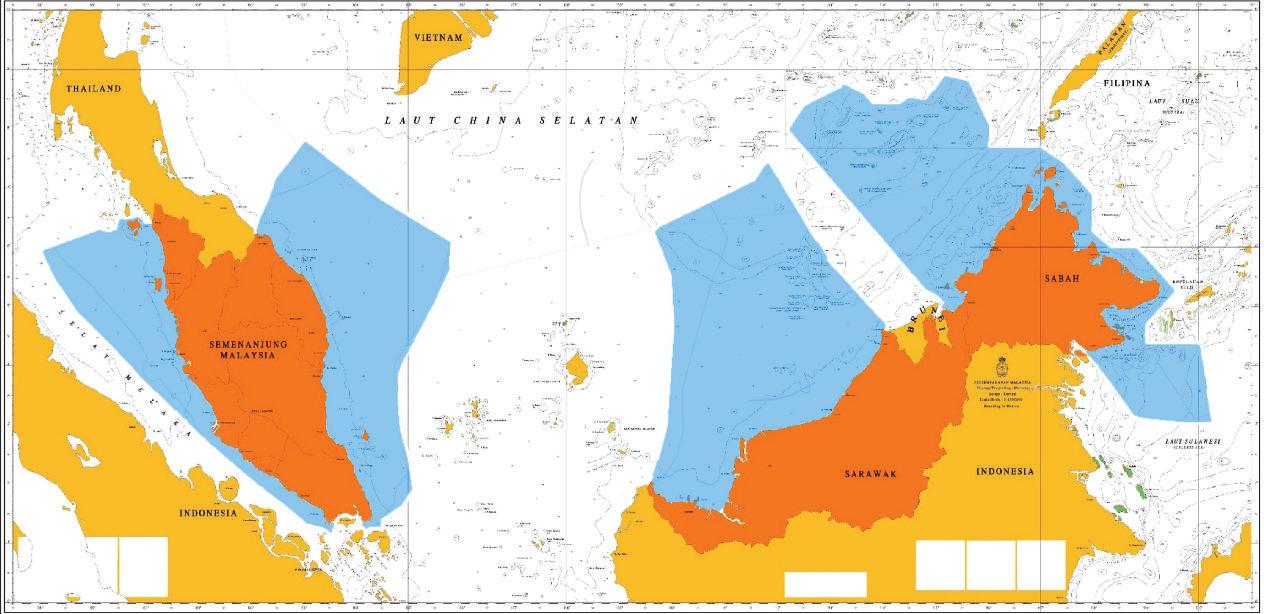

potential vulnerability in the nation's maritime defence. By expanding its coverage to the UMA, the RMN can protect Malaysia's waters from illegal activities and emerging maritime threats, such as piracy, smuggling, and illegal fishing. This will help to safeguard the country's economic interests, protect its territorial integrity, and enhance its standing as a responsible maritime nation.
potential vulnerability in the nation's maritime defence. By expanding the UMA, the RMN can protect Malaysia's waters from illegal activities maritime threats, such as piracy, smuggling, and illegal fishing. safeguard the country's economic interests, protect its territorial enhance its standing as a responsible maritime nation.
The MMZ is a vast area that requires rigorous monitoring and presence by maritime enforcement agencies to safeguard against maritime threats and criminal activities. To formulate the force requirements for an effective maritime presence in these areas, the RMN has divided the MMZ into eight Surveillance Zones that differ in size. Once the Standard Surveillance Blocks determined, the RMN considered the asset requirements using two main methods: Standard Surveillance by Visual Range and Standard Surveillance Using Force Multipliers.
The MMZ is a vast area that requires rigorous monitoring maritime enforcement agencies to safeguard against maritime activities. To formulate the force requirements for an effective maritime these areas, the RMN has divided the MMZ into eight Surveillance in size. Once the Standard Surveillance Blocks determined, the asset requirements using two main methods: Standard Surveillance and Standard Surveillance Using Force Multipliers.




Standard visual identification procedures are based on calculations using a ship's maximum visual identification range under ideal conditions and the maximum time required to cover a 6,000 NM² surveillance area. As illustrated above, a ship's optimal visual identification range for a ship is set at 10 NM, while its economical and maximum speeds are set at 15 and 22 knots, respectively. Based on these parameters, it has been determined that a ship would require 23 hours to cover the surveillance area and a maximum of 5 hours and 18 minutes to respond during emergencies at maximum speed.
The standard surveillance procedures utilising force multipliers involve calculations that incorporate a ship's maximum visual identification range through sensors, organic helicopters, in-support air assets from RMN and other related agencies, and the maximum time required to cover an 18,000 NM² surveillance area. As depicted in illustration at the next page, a ship's optimal visual identification range is set at 30 NM, while its economical and maximum speeds are established at 15 and 25 knots, respectively. Based on these parameters, it has been ascertained that a ship would require 28 hours to cover the surveillance area and a maximum of 8 hours to respond during emergency situations at maximum speed.



Multiplier Factors: • Organic Helicopter • In-Support Air Asset
Block Area of 18,000 nm²
time at the furthest (206 nm)







To effectively execute an effective maritime presence and enforcement activities in the designated zone, a minimum of 12 RMN vessels must be physically deployed and maintained around the clock (24/7) along the all surveillance zones around the MMZ. This ensures that the resources available are sufficient to provide optimal coverage to detect, monitor, and respond to any potential maritime threats. With an optimal detection rate and faster response time, the RMN can effectively cover the entire MMZ and maintain a high level of security to prevent any unlawful activities in Malaysia's maritime domain.
It is apparent that the evaluation conducted by the SSB had necessitated the RMN deploying 12 vessels to ensure round-the-clock maritime presence along the MMZ. It should be noted, however, that these vessels do not encompass the RMN's strategic assets, such as submarines and priority assets, such as the combatants, or its supporting assets, such as logistic ships, mine hunters, and survey vessels. Moreover, these assets must undergo a respective maintenance and management cycle for regular rotation and upkeep to achieve optimised capability and sustainability.
Taking these factors into consideration, the RMN then calculated the total numbers of assets required using the "1/3 Management Concept". The 1/3 concept is a management approach used by the RMN to ensure its fleet's optimal utilisation and maintenance. Using this concept, the RMN divides its fleet's management into three main fragments: one-third of the fleet is on active operational duty, one-third is ready to be deployed, and the remaining one-third is undergoing maintenance, repairs and training. Based on this equation, it is found that RMN ideally requires 36 ships to achieve a maximised maritime presence along the MMZ, which will be covered mainly by the Maritime Surveillance Assets, such as the New Generation Patrol Vessel (NGPV)/Corvette and Littoral Mission Ship (LMS).
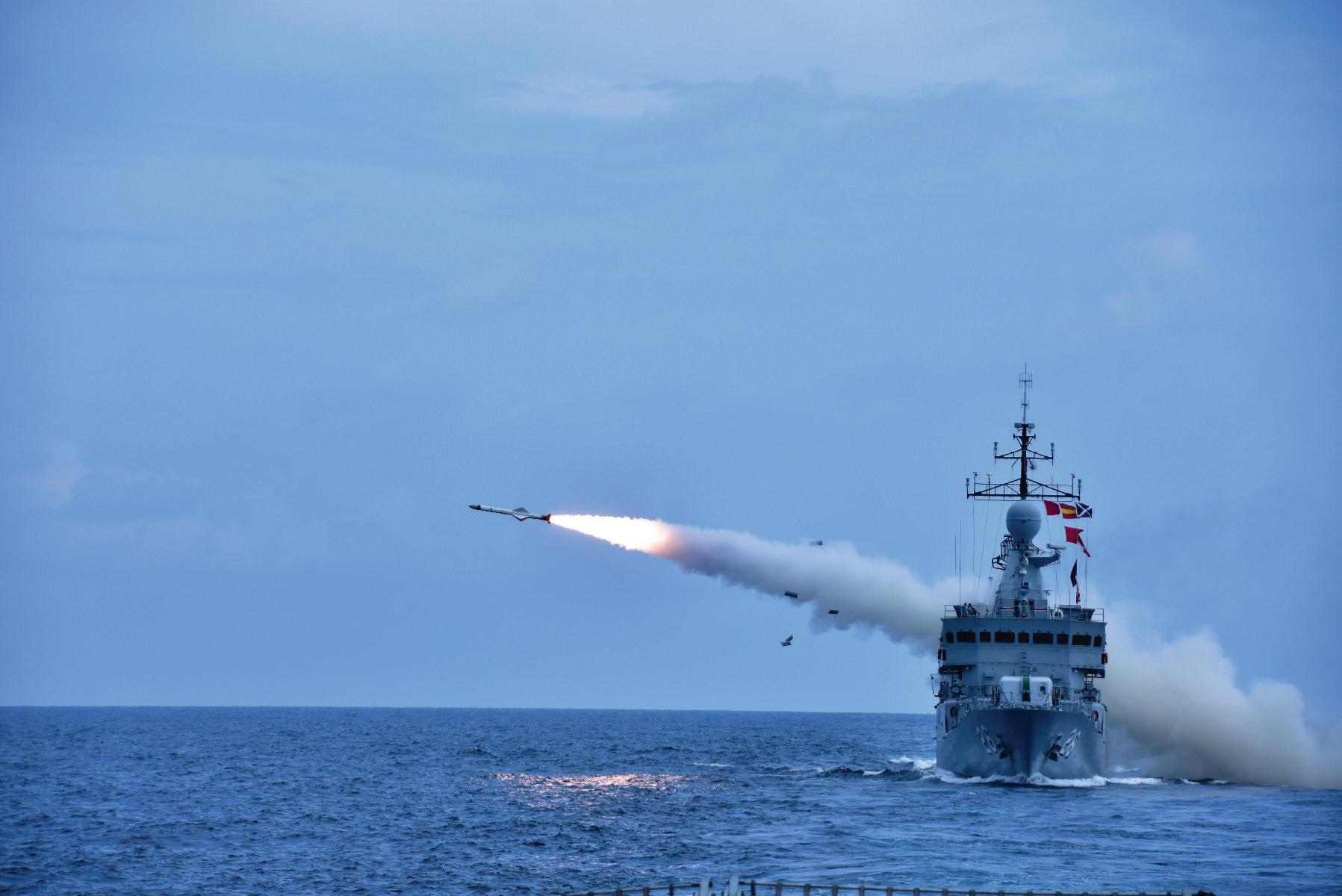
In addition, the RMN also factored in the requirements for strategic assets such as submarines, priority assets such as the combatants, and supporting elements such as the Multi Role Support Ships (MRSS), Mine Counter Measure Vessel (MCMV), Hydrographic Survey vessels, diving and submarine support vessels. To account for these additional requirements, the RMN would need approximately 61 ships to guarantee an optimal operation in the MMZ and realise the Fleet In Being concept. This requirement is named the RMN Baseline Force and will be briefly explained in the next chapter of this paper.

This section of the document will present a comprehensive discussion on RMN's approach to re-aligning the RMN 15to5 Transformation Programme. This strategy centres around creating the RMN Baseline Force, which involves defining its concept, establishing the composition of its respective Fleet and Task Groups, and outlining the advantages of this strategy.
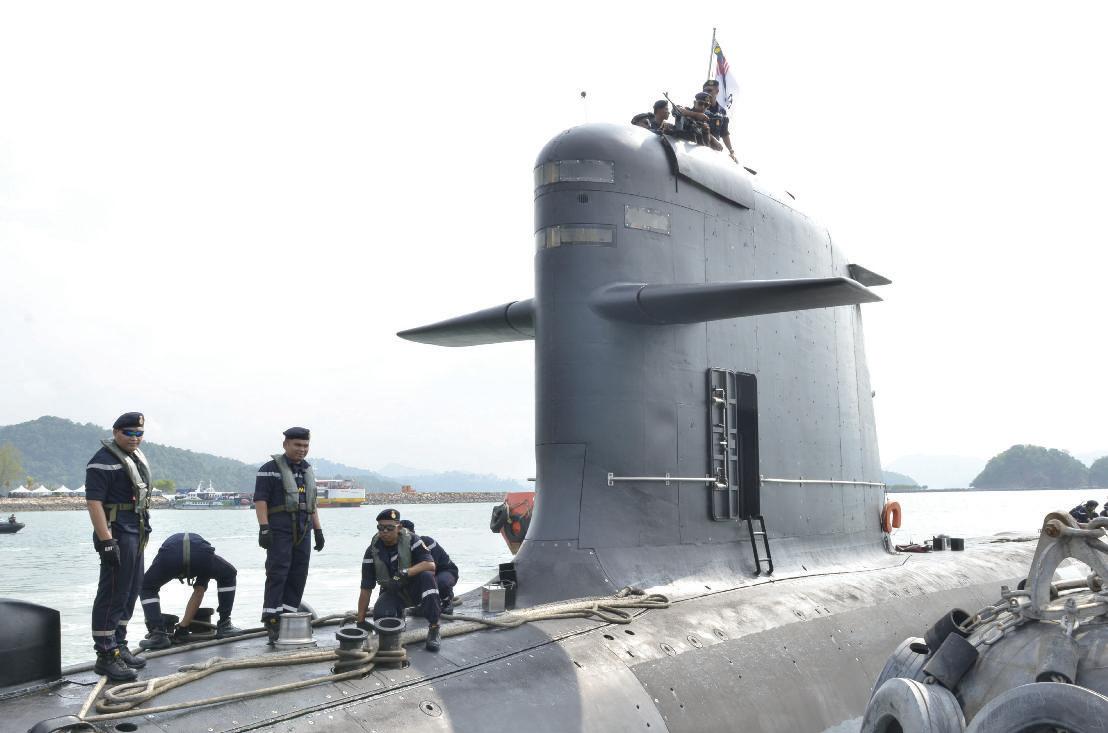

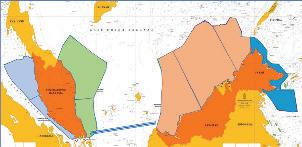
In order to achieve optimal surveillance and maritime presence, the RMN must develop appropriate capabilities of its fleet to safeguard the nation's Critical National Interests and protect its two main land masses and the strategic waterways along the MMZ. Developing these capabilities will also enable the RMN to realise its aim of becoming a Fleet In Being, which is crucial for effectively carrying out sea denial, naval deterrence, and sustainment activities.
The concept of Fleet in Being refers to a naval strategy where a weaker naval force avoids decisive engagement with a stronger opponent but maintains a credible threat by simply exist. The idea is that the mere presence of this fleet poses a threat to the enemy, even if it does not actively engage in combat. Then, a Fleet in Being can contribute to sea denial by dissuading the enemy from entering or controlling certain areas of the sea. Even though the fleet might not be able to decisively defeat the enemy, its presence can make it costly or risky for the enemy to operate freely in those waters. The presence of a Fleet in Being can act as a deterrent against aggression by threatening the enemy's maritime interests. The fear of potential consequences from engaging with the fleet can dissuade adversaries from taking aggressive actions. Sustainment refers to the ability to maintain a military force over time.
A Fleet in Being, by avoiding decisive engagements, can conserve resources and sustain itself for extended periods. This allows it to continue exerting influence and posing a threat to adversaries over the long term, even with limited resources. In essence, a Fleet in Being leverages the psychological and strategic impact of its presence to achieve objectives related to Sea Denial, Naval Deterrence, and Sustainment without necessarily engaging in direct combat.
To achieve these goals, the RMN must carefully formulate its fleet's concept and also disposition. This requires a thorough understanding of the operational environment and the potential threats that may arise. Furthermore, the RMN should ensure that future RMN assets can conduct effective surveillance, defensive and offensive actions.
The RMN must also clearly understand its capabilities and limitations to develop a comprehensive and effective force disposition strategy. By carefully formulating its force dispositions, the RMN can ensure that its assets are positioned in a manner that allows for effective response to any potential threats.
The RMN Baseline Force results from the RMN's future force development strategy, which comprises 61 ships of different types, classified into three main groups: The Sub-Surface Group, Surface Group and Support Group. The total number of this baseline force is based on the number of assets required to guarantee an effective surveillance and maritime presence along the MMZ, and the need for RMN to enhance its deterrence and sealift capabilities through the strategic, priority and support assets.
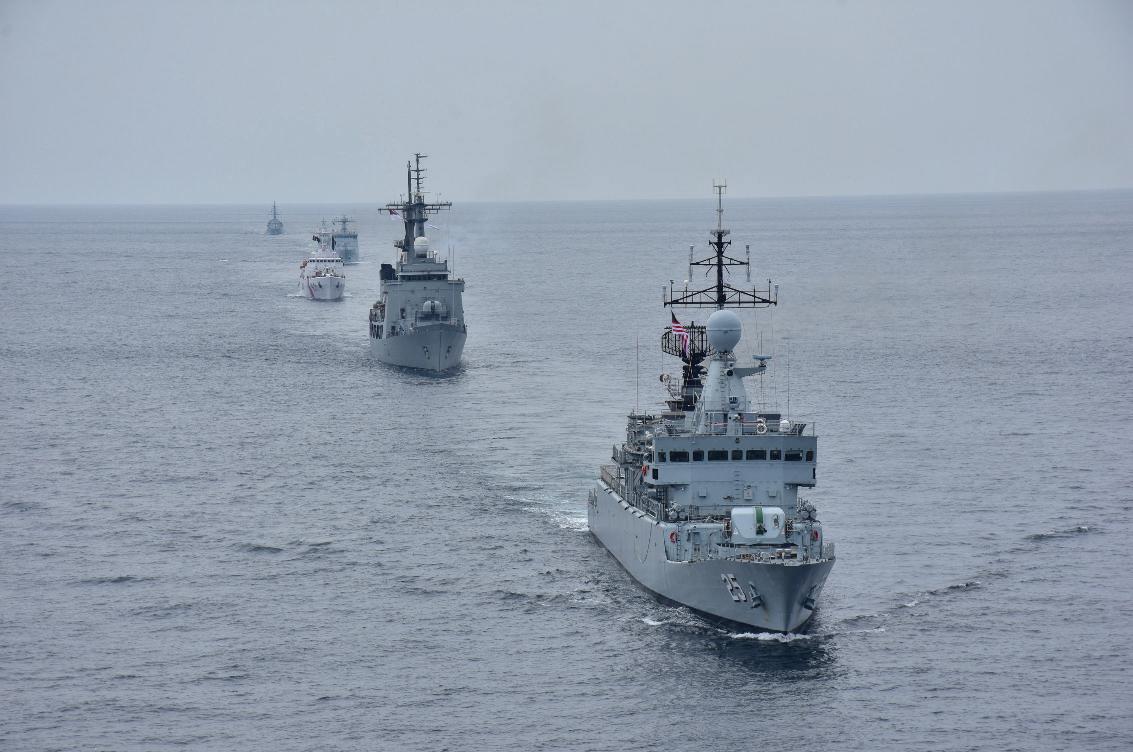
STRATEGIC ASSETS (4 X SUBMARINES). The submarines are considered strategic assets for RMN due to their unique capabilities, including their ability to operate covertly and remain undetected in a range of environments. Submarines can be employed for various purposes, such as intelligence gathering, reconnaissance, surveillance, and offensive operations. They can also protect national interests, project power, and deter potential adversaries within the Extended and Forward Concentric Areas. Submarines require specialised training, maintenance, and logistical support, and their deployments are often carefully planned and coordinated with other naval assets. Overall, submarines are a crucial component of a modern naval force, providing significant strategic advantages to navies in a variety of operational contexts. The basic configuration for the submarines are as required to the nature of operations in Malaysian Waters, equipped with modern systems, required tactical considerations for speed and range. The displacement of the Strategic Asset is approximately more than 1500 tons.
PRIORITY ASSETS (12 X LITTORAL COMBAT SHIP (LCS)). The LCS are considered priority assets for the RMN due to their primary role in conducting offensive and defensive operations at sea. These vessels are typically armed and
equipped with advanced sensor systems, allowing them to engage and destroy a range of threats, including other naval vessels, aircraft, and submarines. The LCS can also be employed for maritime interdiction operations, as well as for the escort and protection of other naval assets such as logistics vessels. Given their strategic importance, the LCSs are crucial for the RMN to maintain maritime security, project power and deter potential adversaries within the Extended and Forward Concentric Areas. In order to effectively conduct the task, LCS need to be prepared with ASuW, AAW, ASW and EW capabilities. The LCS need to be equipped with advance sensors, weapon system, mid-range Air Defence Missile System (ADMS) and with Organic Helicopter capabilites. The LCS is capable of speed more than 28 knots within the range of 5000 nm. The displacement of the LCS is approximately more than 3000 tons.
Maritime Surveillance Assets are essential to a modern naval force, providing critical maritime security and surveillance capabilities. These assets are typically smaller vessels, armed but with limited offensive capabilities compared to the Priority Assets. However, they are highly versatile and can be employed for a variety of purposes, such as maritime interdiction operations, search and rescue, and coastal and littoral operations and are capable of carrying force multipliers. Maritime Surveillance Assets are also important for maintaining presence and situational awareness in areas of interest and can be deployed for extended periods within the Core and Extended Concentric Areas. Due to their relatively low cost and ease of maintenance, navies often employ these assets to enhance their maritime capabilities. As the Maritime Surveillance Assets are divided into two classes of ships, the tasks will be specifically different from one to another.
The Corvettes are capable with ASuW, AAW and EW capabilities. The Corvettes need equipped to be with the Mid-range ADMS and fitted with helideck to conduct helicopter operations or Tactical Drone operations. The Corvettes are capable of speed more than 24 knots within the range of 4000 nm. The displacement of the Corvette is approximately more than 2000 tons.
Meanwhile, the LMS are capable with ASuW and EW capabilities. The LMS need equipped with the Mid-range Rocket Missile System and fitted with Point Defence Missile System (PDMS) or Close in Weapon System (CIWS). Despite not having helideck for helicopter operation, the LMS are capable for Tactical Drone operations. The LMS need to have the capability to achieve speeds exceeding 32 knots over a range of 2000 nautical miles. The displacement of the LMS is approximately more than 500 tons.
MOBILITY (3 X
(MRSS). Maritime Mobility (Strategic Lift) assets are essential to any modern naval force, providing critical tactical provisions, logistical and maintenance support to the combatants and other vessels in the fleet. Amphibious and Strategic Lift assets are responsible for ensuring that amphibious operations are properly conducted, naval vessels are properly supplied, fueled, and maintained, allowing them to remain at sea for extended periods and operate at peak efficiency. In addition to their logistical and maintenance roles, support assets can also be employed for a variety of other purposes, such as humanitarian aid and disaster relief operations. The RMN Baseline Force's support elements is the MRSS and the area of operation for MRSS cover all of The Concentric Areas (Core, Extended and Forward). The MRSS need to equipped with CIWS for self-defense, 2 x Landing Craft Utility (LCU), capable to carry up to 20 various army vehicle and accommodate more than 500 troops. The MRSS is capable to conduct helicopter operations with minimum 2 x helicopter spots and hangar capable for 2 x helicopters. The speed of the MRSS is more than 18 knot with the range more than 10,000 nm. The displacement of the MRSS is approximately more than 5000 tons.
ASSETS (4 X
AND 2 X HYDROGRAPHIC
Support assets are essential to any modern naval force, providing tactical support to the combatants and other vessels in the fleet. Support assets are responsible for ensuring that the specific task are carried out to give tactical advantages to the combatant vessel. In addition to their support roles, support assets can also be employed for a variety of other purposes, such as Search and Rescue (SAR) and underwater search/identification. The RMN Baseline Force's support elements are the MCMV and Hydrographic Survey Vessel.
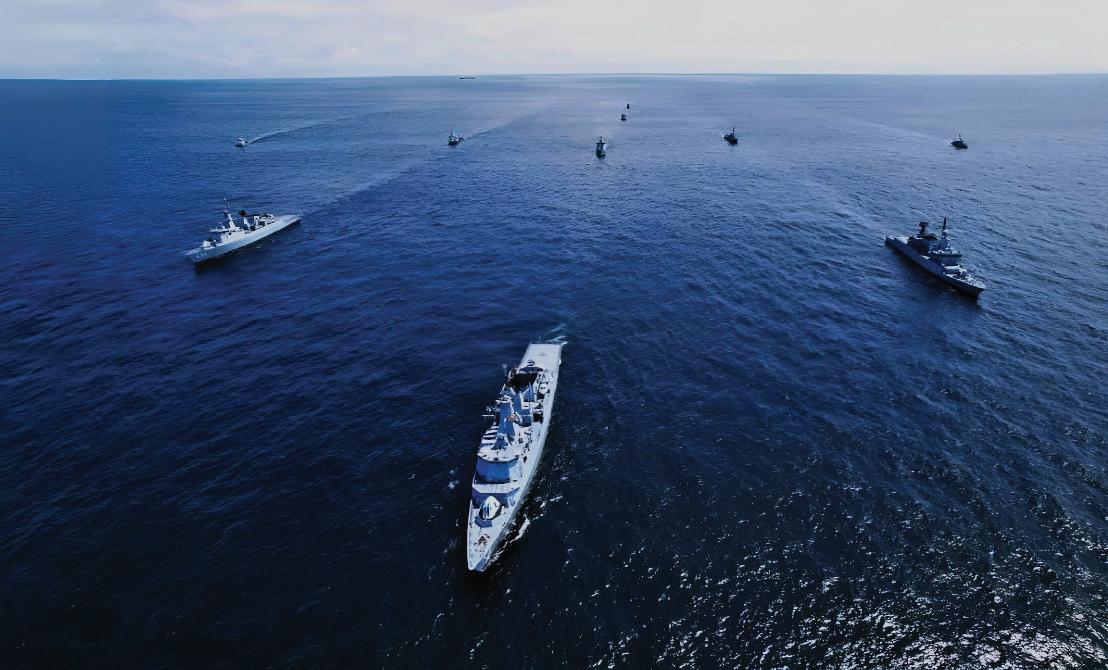
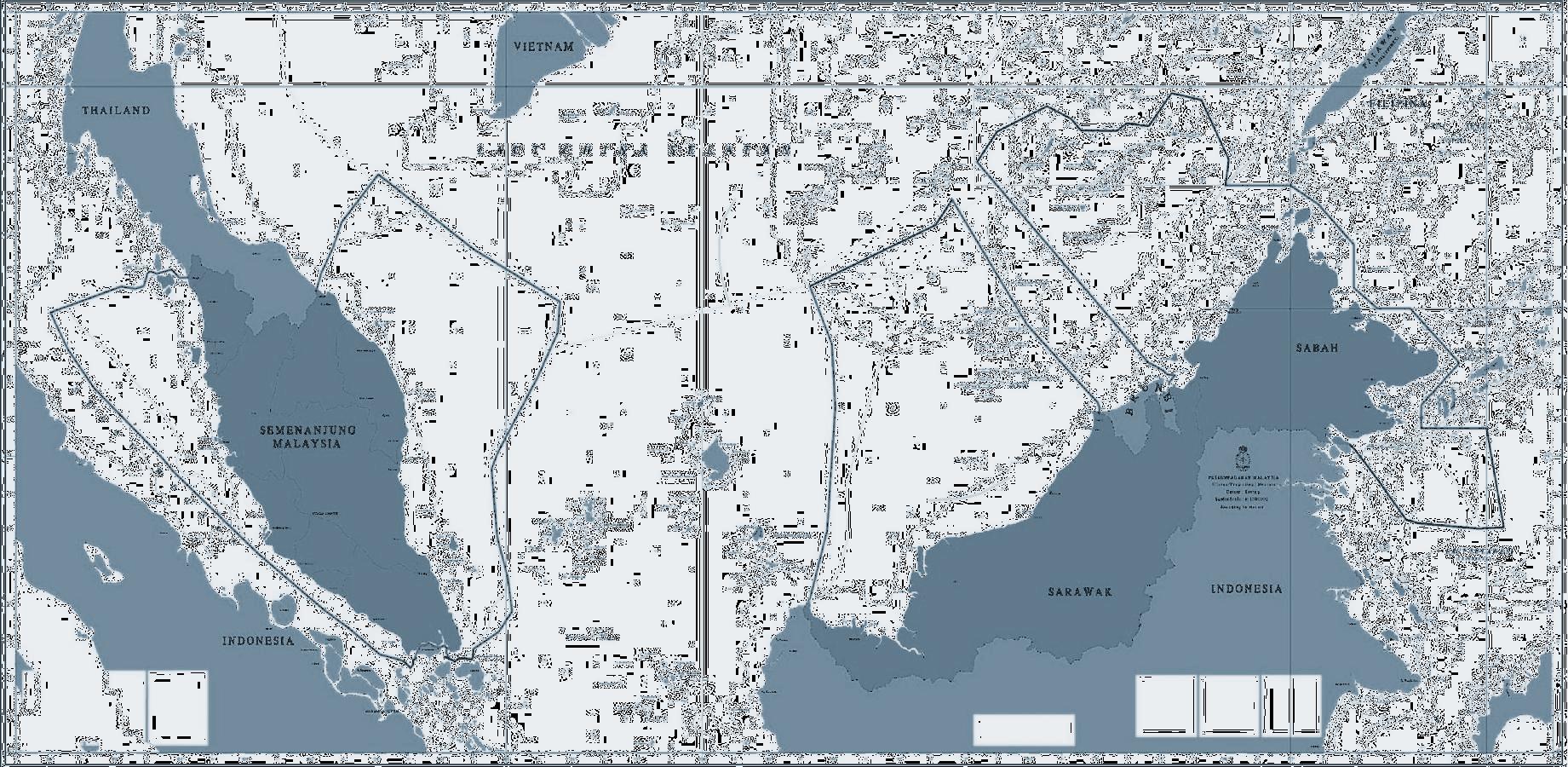

Based on the RMN Fleet’s Disposition, the RMN Fleet planned to be operating in two theaters. The Western Fleet Command will be complemented with 1 squadron of LCS, 1 squadron of Corvette/NGPV, 1 squadrons of LMS, 1 squadron of MCMV plus 2 hydrographic ships. For the Eastern Fleet Command, 1 squadron of Submarines, 1 squadron of LCS, 2 squadrons of Corvettes/NGPV and 2 squadron of LMS. The basis of this fleet dispositions was mainly planned based on current and future threat assessments.


On top of this, two MRSS will be positioned at the Western Fleet Command with the third placed under the Eastern Fleet Command. This is mainly to cater for the logistic movements of the supporting and land elements between two land masses of the country, as most of these support elements are centred mostly in the Peninsular.
Implementing the RMN Force Re-alignment will bring various outcomes and benefits for Malaysia. The strengthened and revitalised force posture of the RMN will not only enhance its capabilities but will also positively impact the MAF and the country as a whole. This will be particularly beneficial in three critical areas: (1) ensuring readiness and sustainability; (2) improving the agility of the fleet; and (3) re-emerging the RMN as a credible and capable force.
The readiness and sustainability of naval assets are crucial for determining their operational effectiveness at sea. In recent years, the RMN has faced significant challenges in maintaining and sustaining its ageing fleet, particularly in responding to increasing commitments and operational demands. The limited number of assets available has resulted in many ships being stretched beyond their normal operational turnover routines, reducing maintenance and upkeep time. This situation has resulted in issues such as obsolescence, degraded capabilities, and increased maintenance downtime, ultimately affecting the long-term readiness and sustainability of the fleet.
Recognising this, the RMN has strongly emphasised developing effective management and maintenance initiatives as part of its force re-alignment plan. The implementation of the RMN Baseline Force is seen as the most desirable solution to achieve the operational effectiveness of the assets. This is because the current approach of stretching ships beyond their Casting Policy is not practical or economical, as demonstrated by the degradation in firepower and capabilities observed over time. As such, the RMN must develop and implement a more sustainable and effective model to ensure that its fleet is always at the highest degree of readiness.
The RMN plans to include force multipliers, including helicopters, unmanned systems, Information and Communication Technology (ICT), and Electronic Warfare (EW) elements, to augment their operational capabilities beyond just using ships alone. This strategic move aimed to enhance the effectiveness of the RMN's operations in the future, besides leveraging emerging
technologies to strengthen the RMN's maritime surveillance capabilities. In addition, the RMN has also revitalised its models and strategies for managing operations, logistics, and administration to ensure the successful implementation of its plans. These newly developed models and strategies will serve as critical support pillars in executing the plan effectively.
Besides that, integrated and adaption of force multiplier will increase the RMN's capability and agility to achieve the Fleet in Being concept. These technologies can expand the reach of the physical fleet by extending the surveillance and monitoring capability of the console officer into the depths of the facility where they could not otherwise reach.
The increased capability and firepower will also benefit the RMN in many ways. Firstly, having greater firepower and asset capability would enhance the RMN's ability to carry out a wide range of naval operations, including maritime surveillance and presence, anti-piracy operations, and search and rescue missions. This would enable the RMN to respond more effectively to maritime security threats, which is particularly important given Malaysia's strategic location in the region and to complement the absence of combat role and firepower with the MMEA assets.
Secondly, greater firepower and asset capability would also help boost the RMN's standing and reputation among other regional navies. This could lead to greater collaboration and cooperation with other maritime nations, further enhancing the RMN's operational capabilities. Finally, greater firepower and asset capability could also help to deter potential aggressors and enhance Malaysia's overall maritime security posture. This would contribute to regional stability and security, which is of critical importance to the economic and political interests of Malaysia and the wider region.
CHAPTER 5
Although the RMN Baseline Force is seen as the desired end state for the RMN, one should realise that it is a long-term plan that may take its pace gradually until it reaches its final aim of Fleet In Being by the year 2050 or beyond. Consequently, the RMN must also undertake the necessary to tackle the obsolescence of its present fleet while at the same time charting necessary measures to bridge the widening capability gap with adequate firepower and capabilities across all warfare domains to ensure its relevance while awaiting the integration of new assets into its inventory.
The following section of this document will outline the FS 40, which represents the RMN's interim initiatives to maintain its current fleet's capability with reasonable firepower and warfighting capabilities. These initiatives will be implemented alongside integrating new assets in the RMN Baseline Force on a reasonable timeline.


In response to the widening capability gaps resulting from the ageing and deterioration of its current fleet, the RMN has implemented two important measures under the FS 40. These measures will be executed within the framework of the Twelfth, Thirteenth, Fourteenth and Fifteenth Malaysia Plans (MP12, MP13, MP14 and MP15) until 2040, aiming to maintain and sustain the present fleet's capabilities.
The first measure is the Re-Life Programme, which seeks to sustain and upgrade the existing fleet to achieve the desired sustainability and firepower while awaiting the procurement of new assets. This programme includes several initiatives such as the Service Life Extension Programme (SLEP) for Frigates and NGPVs, Mid-Life Upgrade (MLU) of the Scorpene Submarines, and Obsolescence Programme (OP) of Fast Attack Crafts and Laksamana Class Corvettes. In addition, the RMN has also initiated the Obsolescence Management (OM) programme, which aims to replace and upgrade obsolete systems and equipment onboard its ships. The programme also seeks to improve the maintenance and sustainability element of the fleet through the S.M.A.R.T Refit Program. These initiatives are crucial in maintaining the RMN's capabilities and ensuring its relevance while awaiting the integration of new assets into its inventory.
It is important to note that while the Re-Life Programmes offer an interim solution to mitigate the widening capability gaps of the RMN's ageing fleet, these initiatives are only temporary measures. Upgraded platforms will only last up to their maximum service life, and they will need to be decommissioned once they reach the maximum life extension period or sustain any defects that jeopardise their operational readiness status. Operating and upgrading these platforms beyond the intended age plan is deemed less feasible and provide less return on investment to the RMN.
The revised Phasing In and Phasing Out (PIPO) Plan will provide details of the service life of each upgraded asset, including the expected timeline for phasing out. The PIPO Plan will also help the RMN ensure that its fleet remains
operationally effective and relevant by balancing between introducing new assets and decommissioning obsolete ones. By implementing the PIPO Plan, the RMN can maintain a sustainable force structure capable of meeting current and future challenges.
Apart from the Re-Life Programmes, the RMN has undertaken additional measures to improve the effectiveness of its existing fleet through various force multipliers. By leveraging emerging technologies as force multipliers, the RMN aims to address the widening capability gaps resulting from the ageing and deterioration of its current fleet and to restore its combat prowess to the best level and condition. The use of force multipliers is a common practice among navies worldwide, as they allow for the integration of advanced technologies and equipment onto existing platforms, which can expand the surveillance footprint and address evolving dynamics in modern warfare involving both state and non-state actors. By using force multipliers, the RMN can enhance the capabilities of its existing fleet and maintain its relevance in the region as a maritime power.
Using force multipliers involves the integration of advanced technologies and equipment onto the existing fleet, enhancing its capabilities and increasing its combat effectiveness. This includes integrating advanced weapons systems, such as surface-to-air missiles, anti-ship missiles, and torpedoes, as well as advanced sensors and communications systems. The use of unmanned aerial and underwater vehicles, along with the deployment of special operations forces, also enhances the RMN's ability to conduct surveillance, reconnaissance, and covert operations.
The use of force multipliers is a cost-effective measure that enables the RMN to maximise the capabilities of its existing fleet while awaiting the integration of new assets into its inventory. This measure provides the RMN with the flexibility to adapt to changing threats and challenges and the ability to conduct operations in a wider range of environments. By enhancing its existing fleet's effectiveness through force multipliers, the RMN can maintain its relevance as a credible naval force and effectively fulfil its mandate to safeguard Malaysia's maritime interests.

Capability is a relative notion, in terms of the application of force. Confronted by a poorly trained, ill-equipped enemy lacking in motivation we might possess considerable capability but faced by a world-class opposition force we might have a rather more limited capability
Gen Andrew Figures, DCDC, UK Defence Academy (2007)
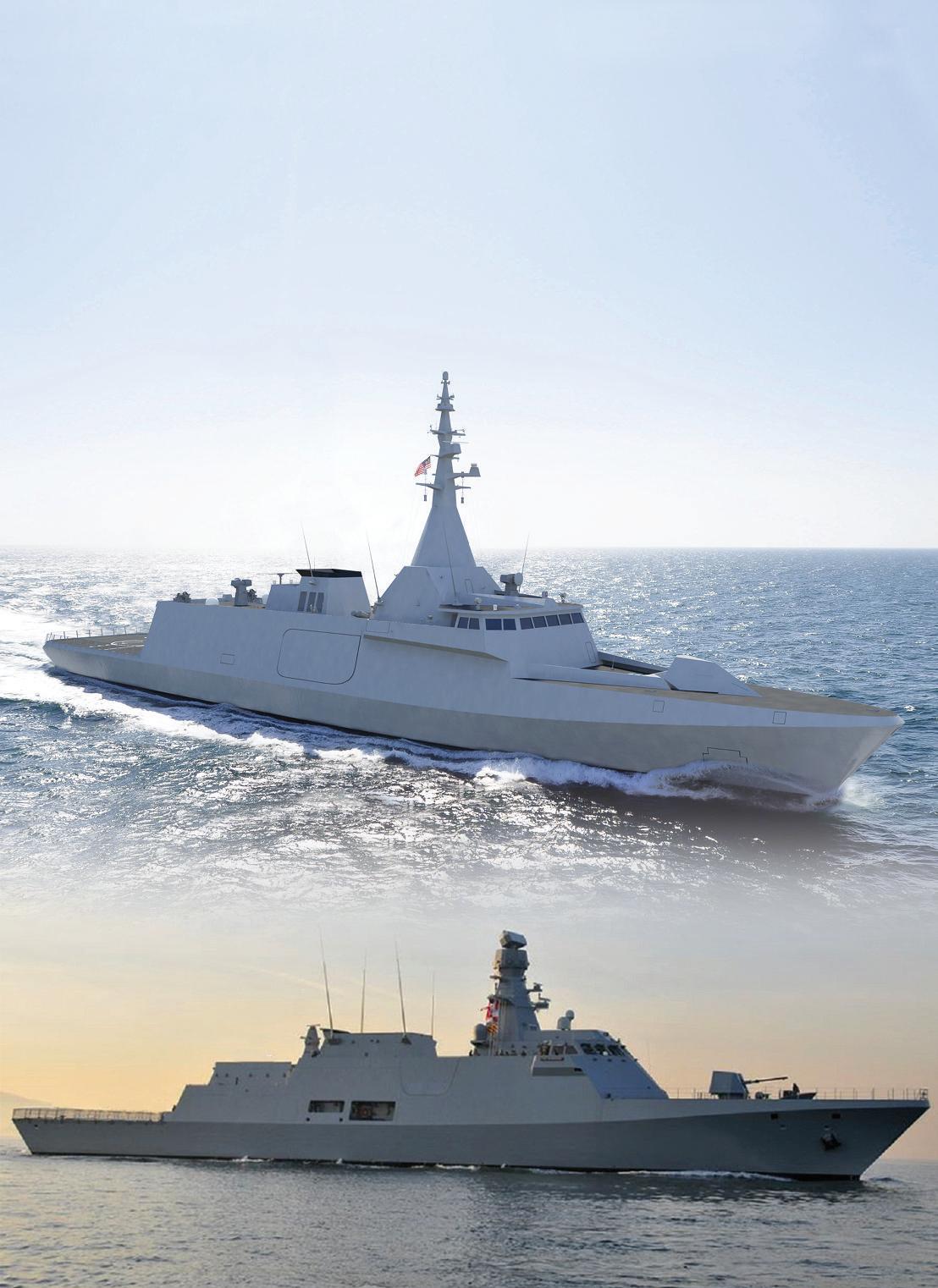
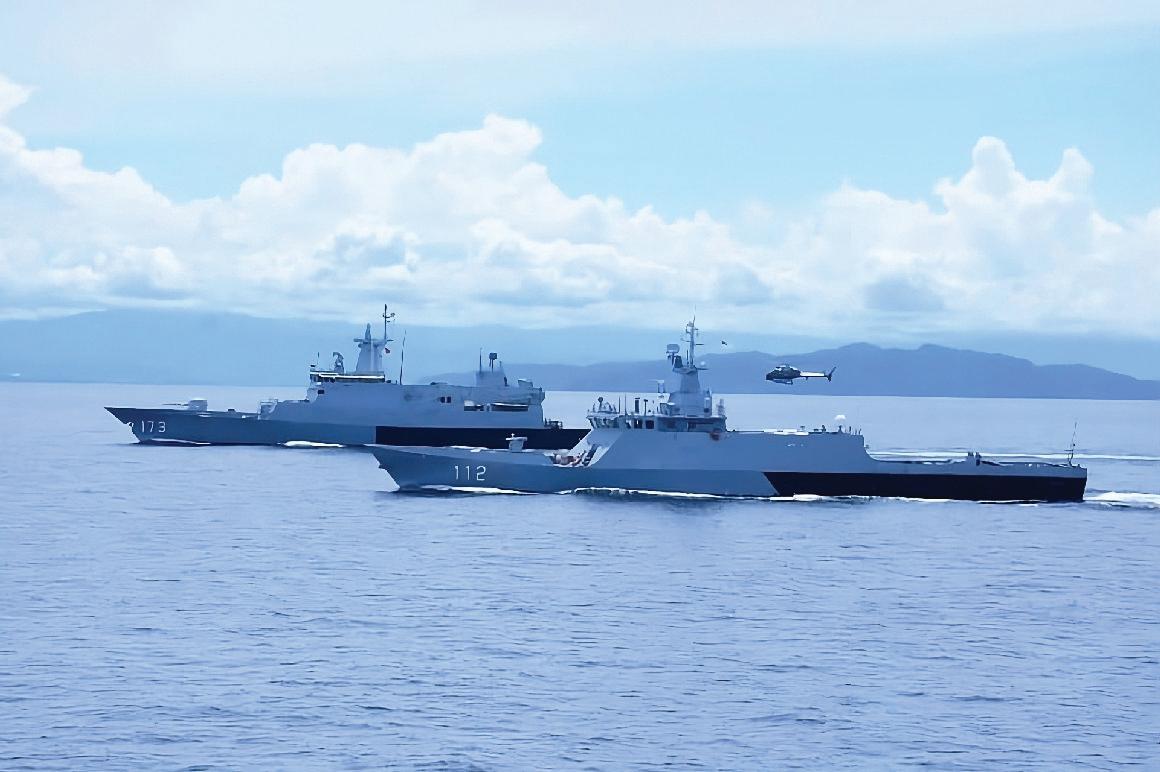
While the RMN's plans and proposals for force re-alignment are promising, it is necessary to supplement them with robust planning processes that are both feasible and fool-proof. Historical experiences have shown that several risks and challenges could arise and disrupt these plans along the way. Therefore, the RMN needs to acknowledge these risks and challenges and carefully formulate the necessary mitigation plans to ensure the achievement of its goals.
In addition, effective planning processes should include a thorough analysis of the RMN's current capabilities and readiness, considering the evolving threats and changing geopolitical landscape from time to time. In implementing these plans, it is also essential to consider the availability and affordability of resources, including financial and human capital. The planning processes should be transparent, involving all stakeholders, and based on a sound risk management framework to identify and address potential risks and challenges. By adopting a comprehensive and structured approach to planning, the RMN can ensure the successful implementation of its force re-alignment plans and maintain its maritime supremacy in the region.
The RMN has identified five specific risks that have the potential to impede the successful implementation of its plan to modernise the fleet. These risks pertain to issues related to the capability management practice within the RMN, constraints that may be encountered in sustaining the ageing fleet, concerns surrounding human resources management, the government's willingness to provide the necessary funding to expedite the plan, and the capabilities of the local defence industry supporting the new shipbuilding initiatives, as well as their capabilities in the Maintenance, Repair and Overhaul (MRO) domain. If left unaddressed and unmitigated, each of these aspects could significantly jeopardise the RMN's efforts to modernise the fleet.

Capability Management
Absence of effective and robust capability management process and procurement plan
Sustainability of ageing fleet
Human Resources Management
Government’s commitment
Capabilities of local defense industry
Further delay in new assets procurement may impact the overall plan
Manpower expansion in parallel not sufficient with asset expansion Training requirement for naval personnel
Gun vs Butter Priority to defence
Series of issues and failures in shipbuilding Capabilities of local vendors to cater the MRO for new technologies
Development of RMN Capability Management Strategy New asset procurements must follow through the appropriate planning and implementation phase
Implementation of Navy-wide Risk Management Audit to identify the current situation and formulation of Action Plans
Involvement of academia and strategic think tanks in developing capabilities
Effective maintenance regime required to maintain and sustain the present Fleet
HR to plan the manpower expansion in tandem with the new asset procurement
More allocation for defence budget 'Defence as an investment'
Development of local defence industry
Indigenous products
Collaboration by local vendors
The first risk identified by the RMN is related to the absence of effective and robust capability management processes in the naval procurement plans. This risk arises due to the lack of proper planning and implementation phases required to ensure the successful procurement and management of new assets and current capabilities.
To mitigate this risk, the RMN needs to develop a comprehensive and robust capability management strategy to ensure all new asset procurements follow the appropriate planning and implementation phases. This strategy should include identifying specific capability requirements and developing its Concept of Operation (CONOP), streamlining a feasible procurement plan based on the current financial policies, and implementing a rigorous monitoring and evaluation system. In addition, a Navy-wide Risk Management Audit needs to be conducted to enable the RMN to identify the current issues revolving around the Navy's capability and formulate necessary action plans. The audit will help the RMN to identify potential risks and challenges associated with the capability management process and will allow the RMN to develop appropriate mitigation strategies to address them.
Engaging selected academics and strategic think tanks is crucial in ensuring that the development of appropriate capabilities is supported by detailed analysis and strategic frameworks from both the academic and strategic spheres. The RMN can leverage the expertise and knowledge of these individuals to develop and implement a comprehensive capability management strategy that will meet the current and future needs of the naval force. By doing so, the RMN can ensure that new asset procurements follow appropriate planning and implementation phases while identifying and addressing potential risks through a Navy-wide Risk Management Audit.
Another significant risk identified by the RMN is the sustainability of the ageing fleet. Further delays in procuring new assets may impact the overall modernisation plan. An effective maintenance regime must be established to mitigate this risk to maintain and sustain the current fleet. The RMN must ensure sufficient funds are allocated for the maintenance and repair of the existing fleet to prolong its operational lifespan until the new assets are procured. The procurement of spare parts, repairs, and maintenance should be carefully planned and executed to avoid any unnecessary delays or disruptions.
Moreover, the RMN should explore and adopt innovative and sustainable solutions to enhance the lifespan of the ageing fleet. This can include using advanced technologies such as predictive maintenance, which can identify potential issues before they escalate into major problems. The RMN should also consider partnering with local or international industry players to leverage their expertise and capabilities in the field of maritime maintenance and repair. By adopting a proactive approach towards the maintenance of the ageing fleet, the RMN can ensure the availability and effectiveness of its assets and maintain its operational readiness.
The successful implementation of the RMN's fleet modernisation plan requires adequately skilled personnel to operate and maintain the new assets. The human resources management aspect has been identified as a significant
risk that may impede the achievement of this objective. Firstly, the RMN is concerned that the procurement of new assets may lead to insufficient human resources requirements. Secondly, there may be a lack of appropriate training modules and facilities for naval personnel to operate and man the new ships, especially on the simulators.
To address these challenges, the RMN's HR department must carefully plan its manpower expansion in parallel with the new asset procurement. This may involve requesting additional manpower expansion requirements from the government. Additionally, the Naval Education and Training Command (NETC) must revise all training modules and facilities to meet future operational training needs. The RMN must also allocate sufficient resources towards developing simulators and other training facilities to build the competency of human capital.
The RMN must prioritise the training and development of its personnel to ensure that they have the necessary skills and knowledge to operate and maintain the new assets effectively. The government and RMN must also recognise the importance of investing in the development of human capital, as this will enhance the overall capability and readiness of the Navy. By implementing these measures, the RMN can mitigate the risks associated with human resources management and ensure that it has the right personnel with the necessary skills to support the modernisation plan.
The RMN has identified the government's commitments as a potential risk to successfully implementing its fleet modernisation plan. The first risk pertains to the concept of "guns versus butter" in budgeting, which may result in defence procurements becoming one of the least important priorities, ultimately impacting the modernisation plan. The ongoing fiscal challenges confronting the government may also reduce defence spending, resulting in the closure of the possibility of new asset procurements as planned.
To mitigate these risks, the government must allocate more resources towards the defence budget and acknowledge defence as an investment rather than an obligation. This shift in perception can be achieved by conveying the benefits and positive spillovers that the country will gain by strengthening its
defence capabilities. This may include boosting the local defence industry and creating jobs for citizens. The government must also consider the long-term implications of not investing in defence, such as the country's vulnerability to external threats and the inability to protect its maritime interests.
It is also critical for the government to recognise the importance of a strong defence and its impact on national security. By allocating sufficient resources to defence spending, the government can successfully implement the RMN's fleet modernisation plan, which is vital to safeguarding the country's maritime interests and protecting its sovereignty.
The development of the local defence industry and its capabilities is a critical aspect that can impact the successful implementation of the RMN's fleet modernisation plan. The RMN has identified two significant risks in this regard. The first relates to the series of issues and shipyard failures in shipbuilding that has been a pressing concern, which hampers the government's local naval capability development plans. The second risk relates to the capabilities of local vendors to cater to the Maintenance, Repair, and Overhaul (MRO) needs and adapt to new technologies.
To mitigate these risks, the government needs to promote the development of the local defence industry by providing necessary grants and other opportunities to encourage their growth. One effective strategy is the transfer of technology, which will help local industries develop and enhance their capabilities. The government can also support indigenous defence product development by leveraging the success of the Combat Management System named AMOCS (Advanced Malaysian Owned Combat Management System) onboard KD GEMPITA as an example. By nurturing indigenous capabilities, the RMN can reduce its reliance on foreign technology, thus reducing the risk of supply chain disruptions. Another effective measure is encouraging collaboration between local vendors and credible strategic partners to build their capabilities. Such partnerships can help local vendors gain access to advanced technologies and knowledge, enhancing their capabilities. Additionally, collaboration with established partners can help reduce the risk of project failures and improve the overall quality of work.
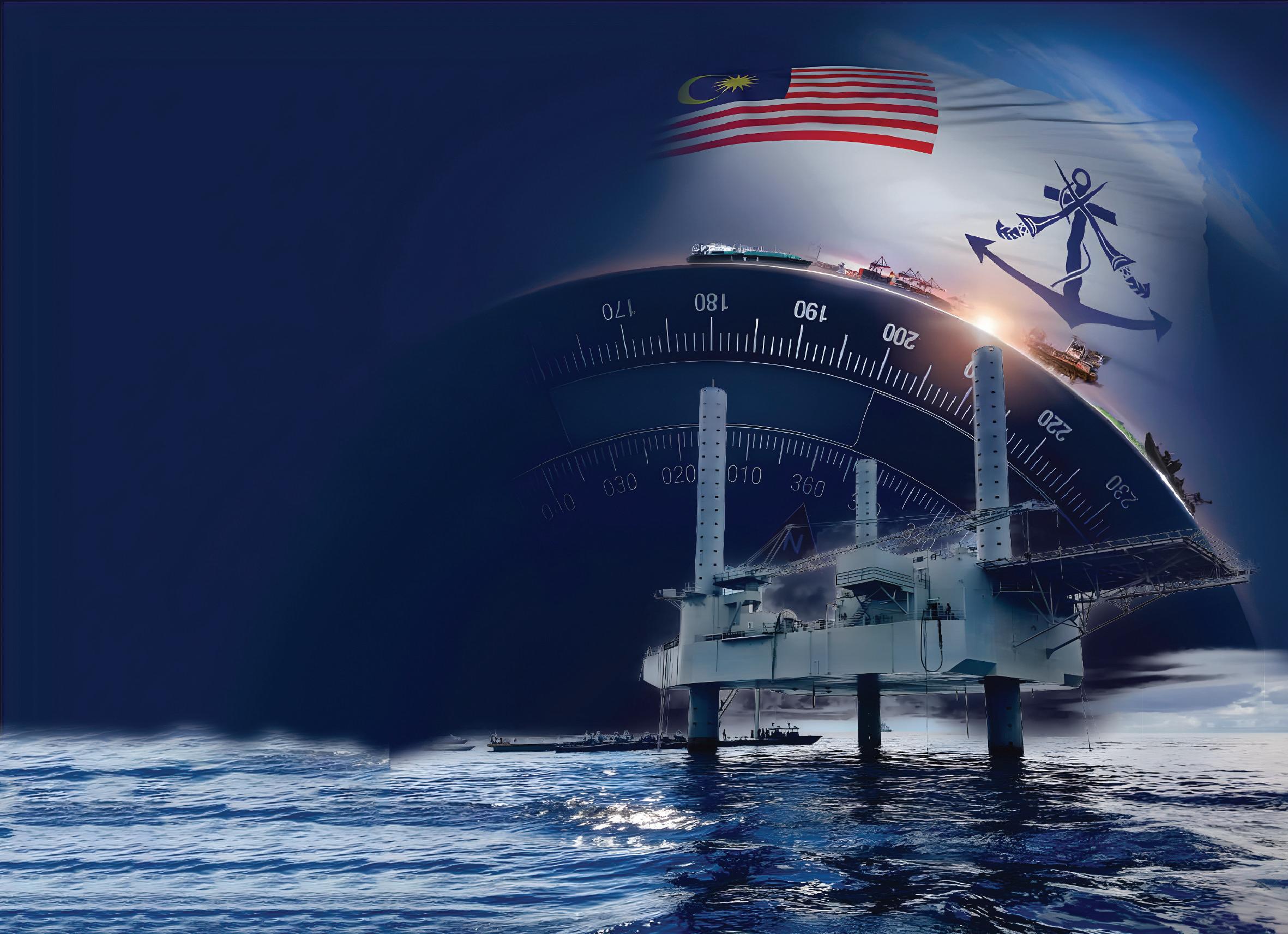
Malaysia's maritime interests are crucial to its socioeconomic well-being and national security. To maintain its strategic position and ensure stability in the region, it is imperative to implement a robust strategy to safeguard Malaysia's maritime interests. The government must address the current challenges and potential threats to national sovereignty promptly and effectively. The re-alignment of the RMN 15to5 Transformation Programme is an important step towards ensuring that the fleet can effectively fulfil its tasks and missions, especially in the face of evolving security challenges. By investing in the military and providing the necessary resources and training, Malaysia can ensure that its armed forces are ready to protect its citizens and safeguard its territorial integrity in the face of any challenge.

The RMN Baseline Force is a long-term plan that outlines the categorisation, capabilities, and disposition strategy of future RMN assets. It is a comprehensive strategy that will ensure the RMN is equipped to address evolving security challenges in the region and protect Malaysia's maritime interests. FS 40, on the other hand, is an interim measure that will bridge the gap while awaiting the completion of the Baseline Force. It is intended to address immediate operational needs and will serve as a stopgap measure until the full implementation of the Baseline Force.
It is crucial for the RMN to recognise the potential challenges and risks that may arise during the implementation of the re-alignment plan. Therefore, it is imperative to identify these risks and develop a comprehensive strategy to mitigate them. The success of the modernisation plan depends on the ability to anticipate and address these risks effectively. Hence, the RMN must prioritise risk management by adopting a detailed plan encompassing potential risks and corresponding mitigation strategies.
In conclusion, the RMN's 15to5 Transformation Programme is a significant step towards ensuring that Malaysia's maritime interests are protected and secured. Implementing the Baseline Force and FS 40 will provide the RMN with the necessary assets and capabilities to effectively address evolving security challenges in the region. It is essential that the RMN also recognises the potential risks and challenges that may arise during the implementation of the re-alignment plan and develops a comprehensive strategy to mitigate them. By prioritising risk management and investing in the military's training and resources, Malaysia can ensure that its armed forces are ready to protect its citizens and safeguard its territorial integrity in the face of any challenge. The successful implementation of the RMN's modernisation plan will undoubtedly contribute to Malaysia's socioeconomic well-being and national security, ensuring it remains a strategic player in the region.
